This month the FCI World Dog Show will be held in Salzburg, Austria. The USA Australian Terrier National Specialty will be held in Missouri this month. ATI wants to wish everyone the best of luck.
With so many devoted Aussie lovers in one place, perhaps it might be a wonderful time to have productive conversations about health. Many countries have requirements about testing that must be done prior to breeding. In the US it is not required.
Does testing matter? Some who do not health test claim it does not. Yet this month you will read about a dog with a possible genetic issue that has cost its owner thousands of dollars. You will also find information about CHIC testing in the US.
Who enforces and/or protects the public from people selling unhealthy dogs or dogs that develop health issues that are costly down the road? Is there a way to help the pet buyer?
As breeders what are our ethical responsibilities, if any, to both the puppies we produce and to the buyers? What are our responsibilities to each other?
As breeders how much are we intellectually responsible to know about a pedigree before breeding into it? Could we know more by asking more questions? Is it good enough for a fellow breeder to say they tested their dog? Should it be our responsibility to see the test results?
As puppy buyers how much due diligence should we do prior to buying our dog? Why is it important to go to the home of your breeder and see the parents and the way the dogs are kept? What are the possible ramifications of wanting an Aussie today and buying one off the internet tomorrow and having it shipped? What are the risks of instant dog ownership gratification and convenience?
I am receiving almost one phone call a week from pet buyers in the US who either have an afflicted Aussie or have just lost one. Last month several people called who had lost their dogs to diabetes and epilepsy; people also called looking for answers to severe food allergy and patella issues.
I’ve heard it said, “When we know better we do better.” Perhaps if we all work together, with honesty and integrity, we can make a difference and keep the future bright for the breed.
Pamela Levy
Editor
Surely Nothing To Lose “Silja” Silja is owned and loved by Birthe and Ole Buch, in Denmark.
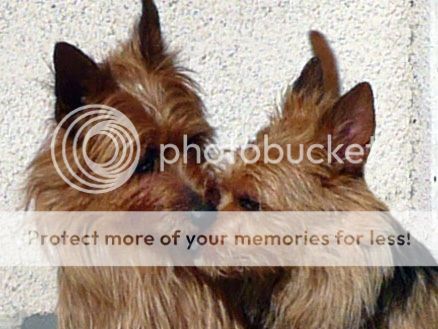
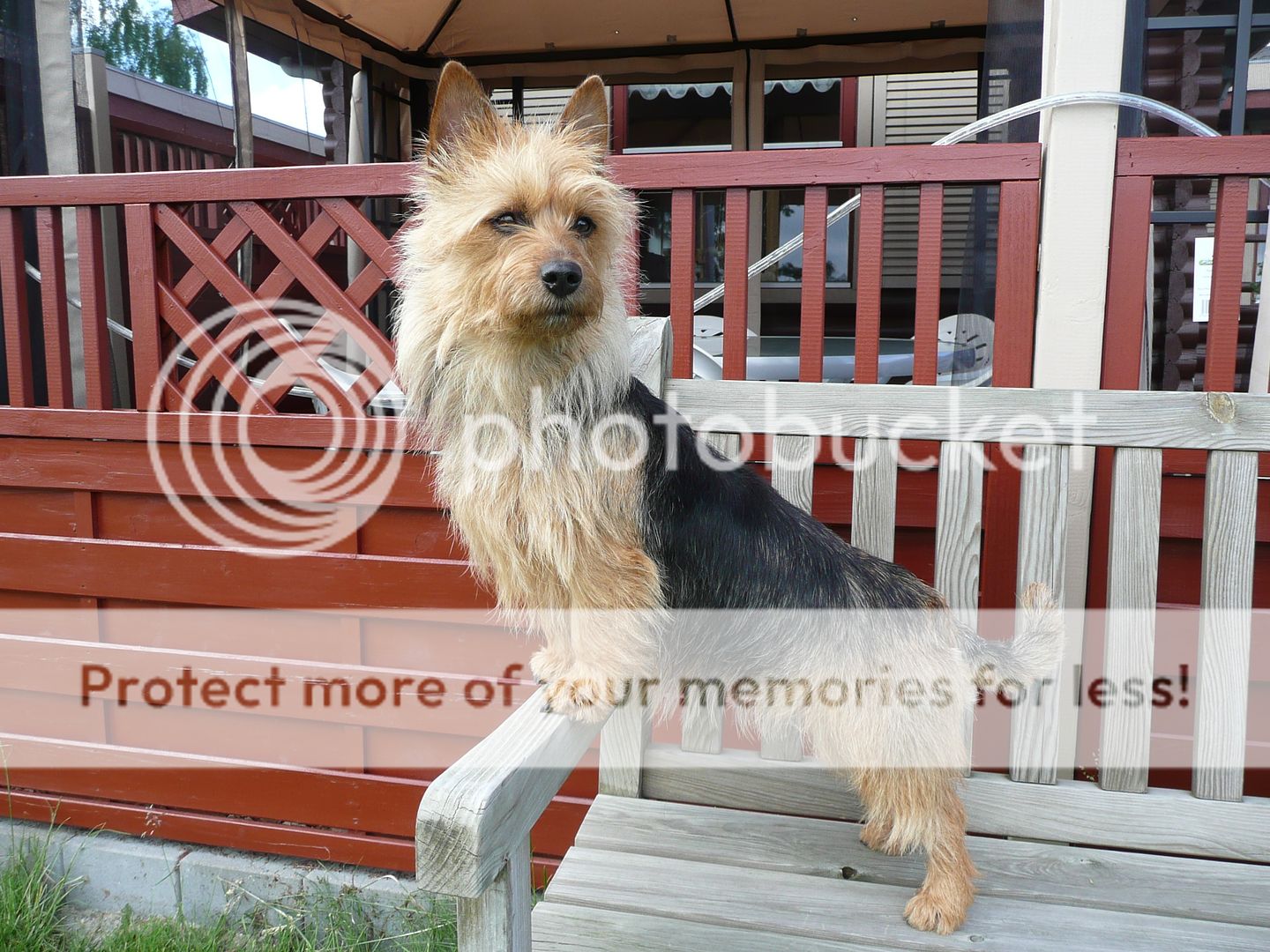
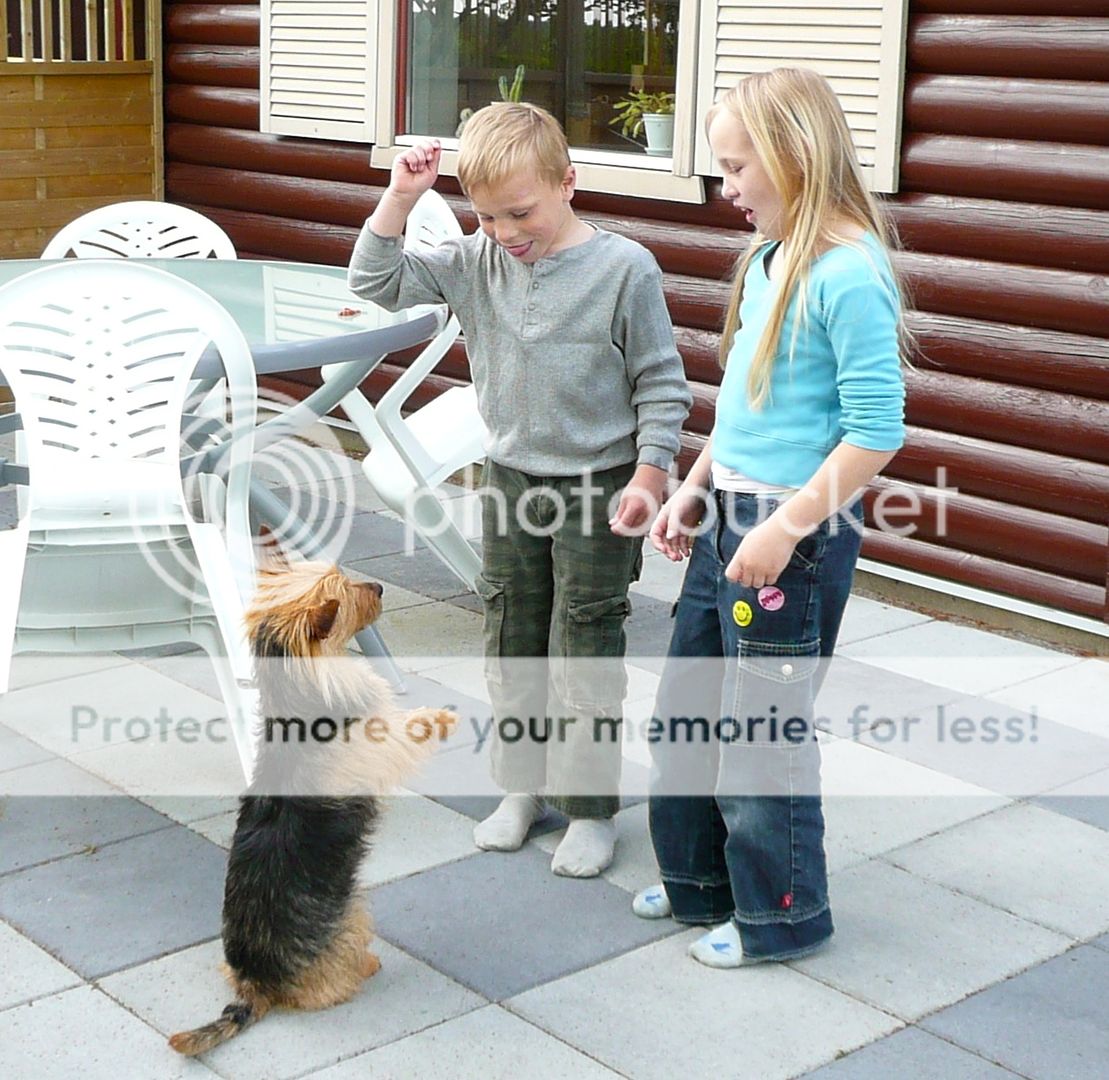

Silja and Svea
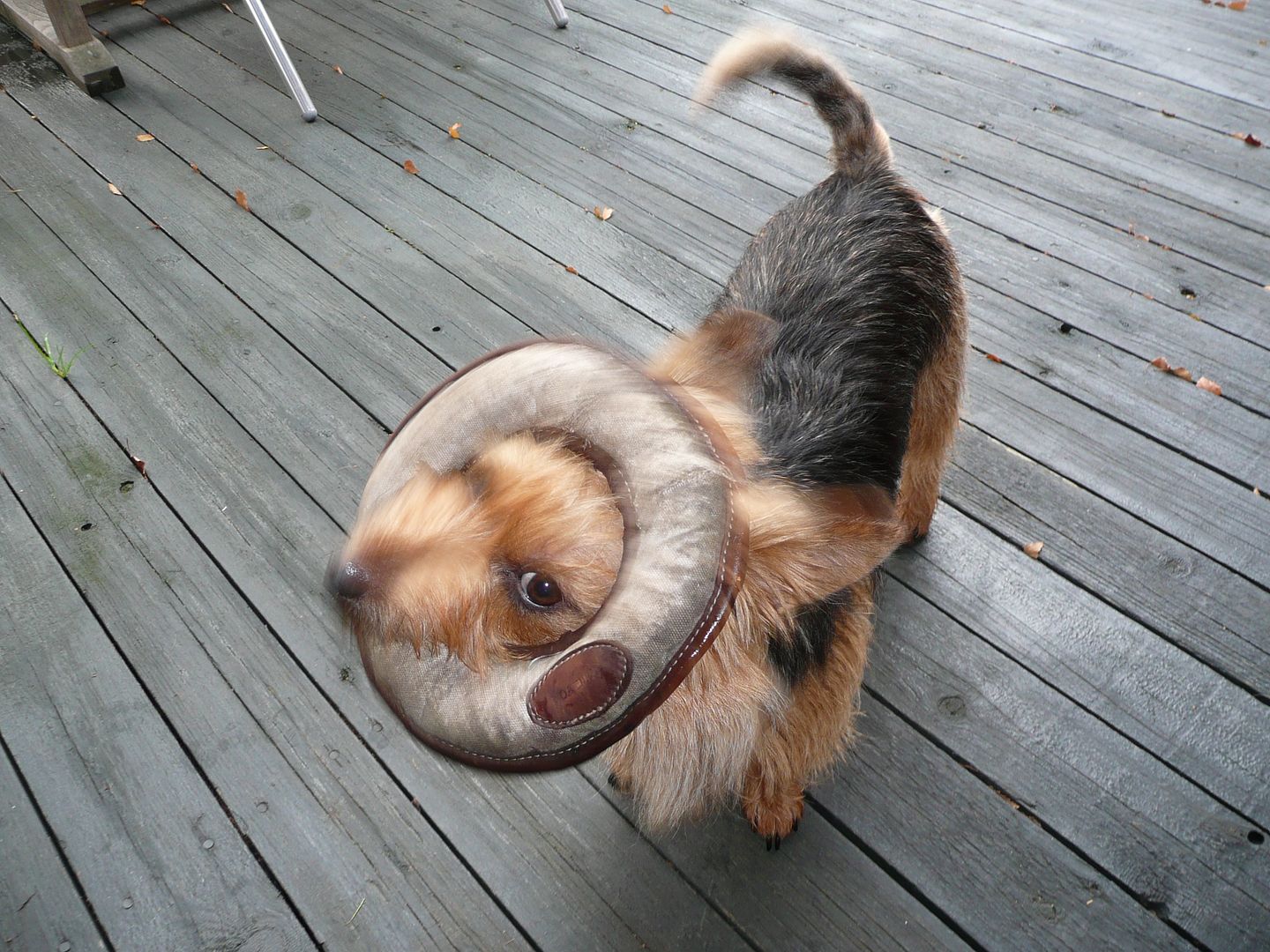
A Trip To Remember By Elaine Strid
This is a story of a breeder flying with her Aussie to Finland in order to breed her with the hope of increasing the US Aussie gene pool.

The finished product but we are getting ahead of ourselves!
After hours of Skype talk and many emails sent and received, in January, 2012, I left my home in the USA for a trip to Finland. But, I am getting ahead of myself. My plan was to take my Aussie, Fergie (GCH CH Roachan’s Live & Let Fly at RedSky), to be bred as well as bring back dog semen if I found promising donors. I also wanted to collect a USA dog residing in Finland. The preparation for this trip was no small feat. Here is my story.
November
I made arrangements with my veterinarian to start the documentation that is required by Finnish customs. Again, this is no small feat. The documentation is quite complicated; anyone thinking of doing this should start this process 60 days prior to departure. It took three attempts before the paperwork was approved by the USDA with three weeks of effort from me, my veterinarian, and the USDA.
I made flight reservations for Fergie and me with Lufthansa. Yes, I did ask for God’s direction as to when Fergie would be in season. As I was only going to be gone for ten days, the timing had to hit just right. I then made reservations for the semen tank that I was taking to Finland in order to hopefully bring back semen. I took the empty semen tank as an extra bag as this was the cheapest way to get the tank to Finland. Renting a tank from Finland would have required shipping it back and therefore been more costly.
Since I was going through Frankfurt, Germany, as part of the original departure plan, the number of dogs that I planned to take went from one to five. Yes, I said five. Two dogs and one leased bitch with her puppy were to be returned to Reimin Kennels. Two more puppies were to go to their new homes; one going to Frankfurt where it would live and the other going to Reimin and Surely Kennels in Finland. This required much more work to prepare documentation for these additional dogs. Since these dogs were traveling with a passenger on the flight (one in the cabin and four in cargo) it was a great savings. The dogs’ transportation cost $200.00 each instead of approximately $750.00 each had they traveled without a passenger.
December
I continued to work on completing the required documentation as well as having the dogs wormed. It took at least three attempts for each of the dog’s paperwork to be correct. The fees for the veterinarian and the USDA to complete this paperwork are about $150.00 to $200.00 per dog.
The next challenge I faced was how to get a female dog to come into season in order to be bred during this trip. Three days prior to departure Fergie was still not in season. Then, the night before the day we were to leave, about 20 hours before our departure, Fergie came into season. That was a big “Hurray!”
After many phone calls and emails, with lots of coordination, Fergie and I, along with the other four dogs, all arrived at the airport on the 29th of December for our flight to Germany. All six of us arrived in Frankfurt on December 30.
My next challenge was to find a way outside the airport for Fergie to have a much needed potty break. She did great on the flight with not a peep, yet, I confess, I took her to the airplane restroom and let her out of her Sherpa bag for a few minutes. As soon as I arrived in the terminal my cell phone rang. Can you believe that it worked without any work on my part? So after a veterinarian check, finding the Frankfurt puppy owners as well as the puppy, which was in the wrong place in cargo, the puppy left with a new, loving family for his new home. Goal number one completed. I was not allowed to see or check the other dogs while they were in Frankfurt, but Lufthansa personnel assured me they would be fed, walked, and watered before their Frankfurt to Helsinki flight.
On the evening of December 30, a Friday, Fergie and I arrived in Helsinki. I had to find a huge cart, load my own bags, load the other three dogs and leave baggage claim on my own. There were no porters available for international travelers. I don’t know when the documentation for the other dogs was checked, but it obviously had been checked as it was all in a different order upon their arrival. Krista Riihela from Reimin Kennels and her friends were a welcome sight when I turned the corner from baggage claim. I was pretty sure that a shower and a pillow was something I wanted as soon as possible.
Now, more work started. I had to make a decision as to what dog’s semen to collect and most importantly who would be Fergie’s mate. I looked at many lovely dogs. The rear angulation and beautiful strong heads of Aussies in Finland are enough to make any Australian Terrier breeder very happy, yet, I was looking for not only that but a genetic background in common with Fergie.
Please don’t think the visit was all work and no play. There was a lovely evening on New Year’s Eve of food, wine and fun with lovely people at the cottage where I stayed. There were great places to hike with Fergie around beautiful farm land. Snow makes Finland quite crisp and beautiful in the sunshine as well as the moonlight. I made a ferry day trip with Satu Harden of Surely Kennel to Tallin, Estonia. This is a quaint Renaissance Russian town in the middle of a modern city. Did I mention it was snowing again? The Black Sea is a little intimidating on a black night, with huge swells in the sea and wind and snow blowing from every direction. I was glad to return to port in Helsinki safe and sound.
January
In a blinding snowstorm, in the early wee hours of the day, on Wednesday, January 4, Irma Harden, Fergie and I, along with three beautiful male dogs, made our way to OpVet, Helsinki. By 10:00 AM the snow had stopped. The three male dogs were collected to have their semen shipped to the USA semen bank. Irma and I took a short break and went back to her home. No rest for the silly people who breed dogs. It appeared that Fergie was ready and Dio (Reimin Master of Puppets) was willing. There was a short interlude between them. On Friday, January 6 there occurred another long interlude between Fergie and Dio. Everyone seemed confident that this was all that was needed to make sure that puppies were swimming back to the USA in Fergie’s womb. With this major accomplishment of getting Fergie bred, I achieved goal number two.
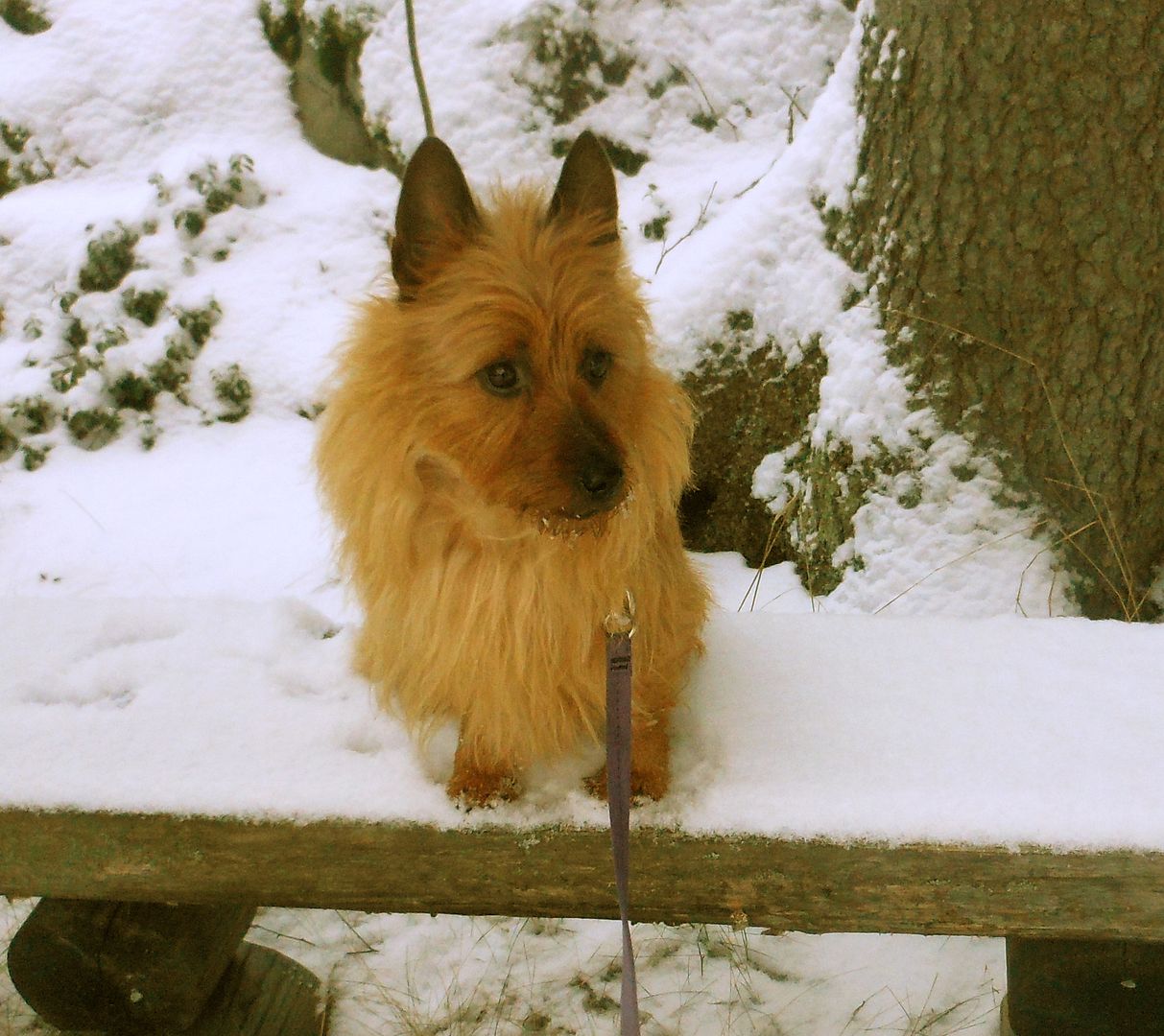
Fergie in Finland
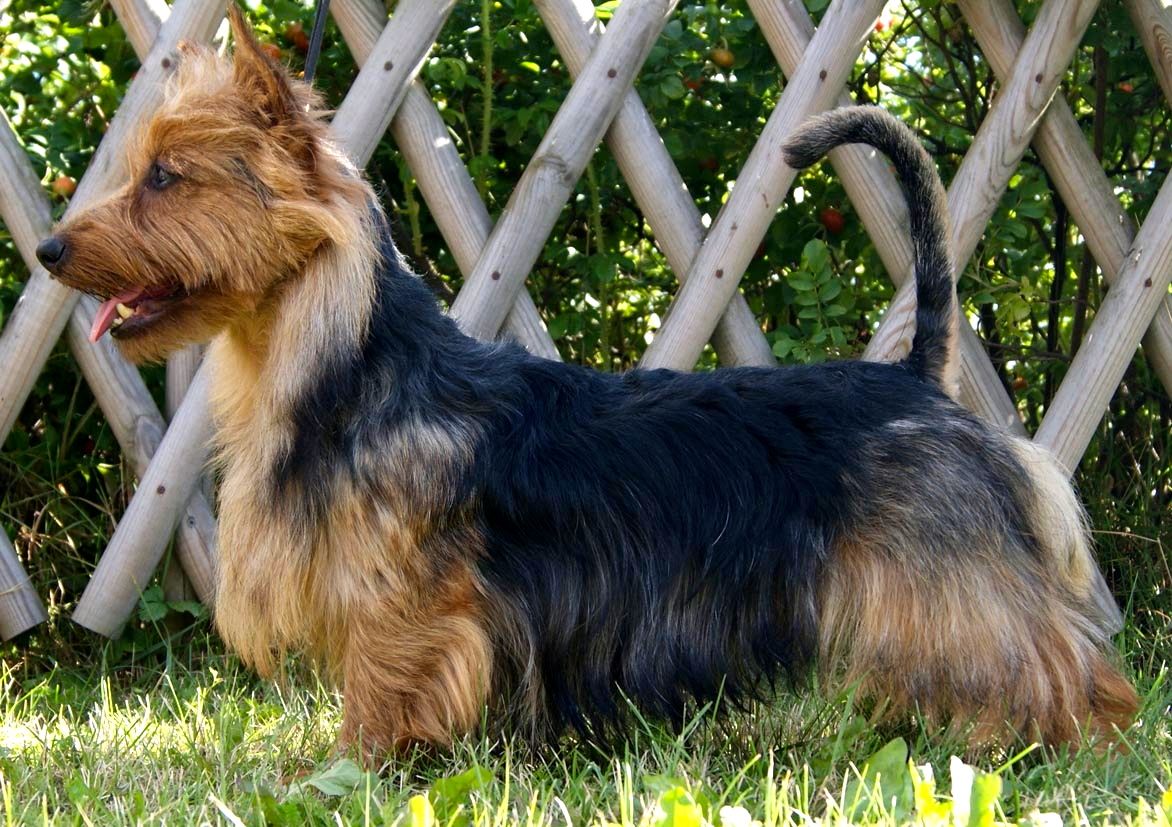
The Papa, Reimin Master of Puppets “Dio”
With what seemed like a short weekend, after a delightful visit to the old town of Porvoo and making deeper friendships it was now time to return home to the USA. So on the following Monday we headed back to Helsinki with dear Irma for our flight back home. It seemed impossible that we had only been gone for ten days. So much had happened during this trip. Fergie simply was a great little trouper on the flight home. We missed the connection in Frankfurt to go to Chicago so they rushed us over to a direct flight to Denver. There was no time for a pit stop for poor Ms. Fergie, so off we went to Denver. Can you believe she made it for about 16 to 18 hours without a pit stop? I am sure I would not have made it that long. We were both glad to be back in the USA.
After coordinating emails from OpVet and the International Canine Semen Bank in Brighton, Colorado, I learned that all of the semen arrived on February 4! Goal number three completed with the frozen “boys” safe and sound in the USA. They are waiting for an opportunity to add to the USA Australian Terrier genetic pool.
February
Fergie had an ultrasound on February 8 finding her pregnant with five or more puppies. Whelpwise hunted for puppy heartbeats the last of February and we found six.
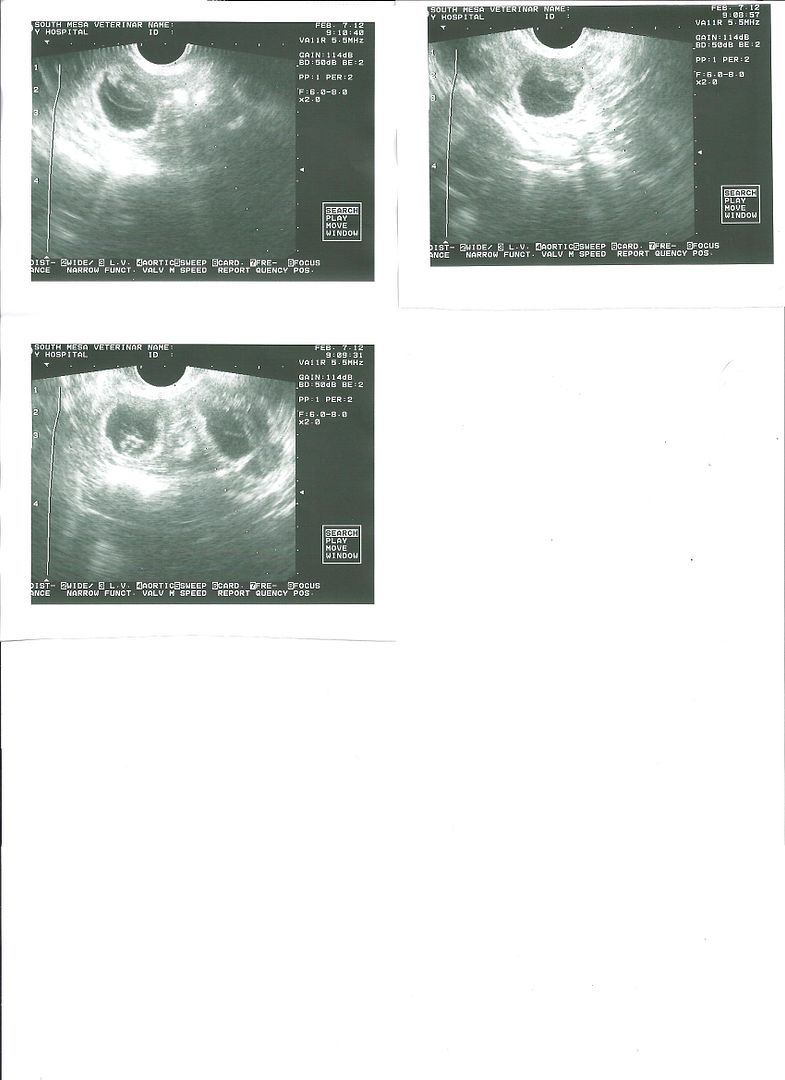
March
On March 7 we welcomed six puppies into the world, five blue/tans (two females and three males) and one red male. Sadly, one little blue/tan male weighed only 3.75 ounces. I worked very hard to get his weight up, spending much time trying to get him to nurse as well as giving him supplemental feedings. After less than 48 hours we lost him. It hurts when you lose a puppy you try so desperately to save.
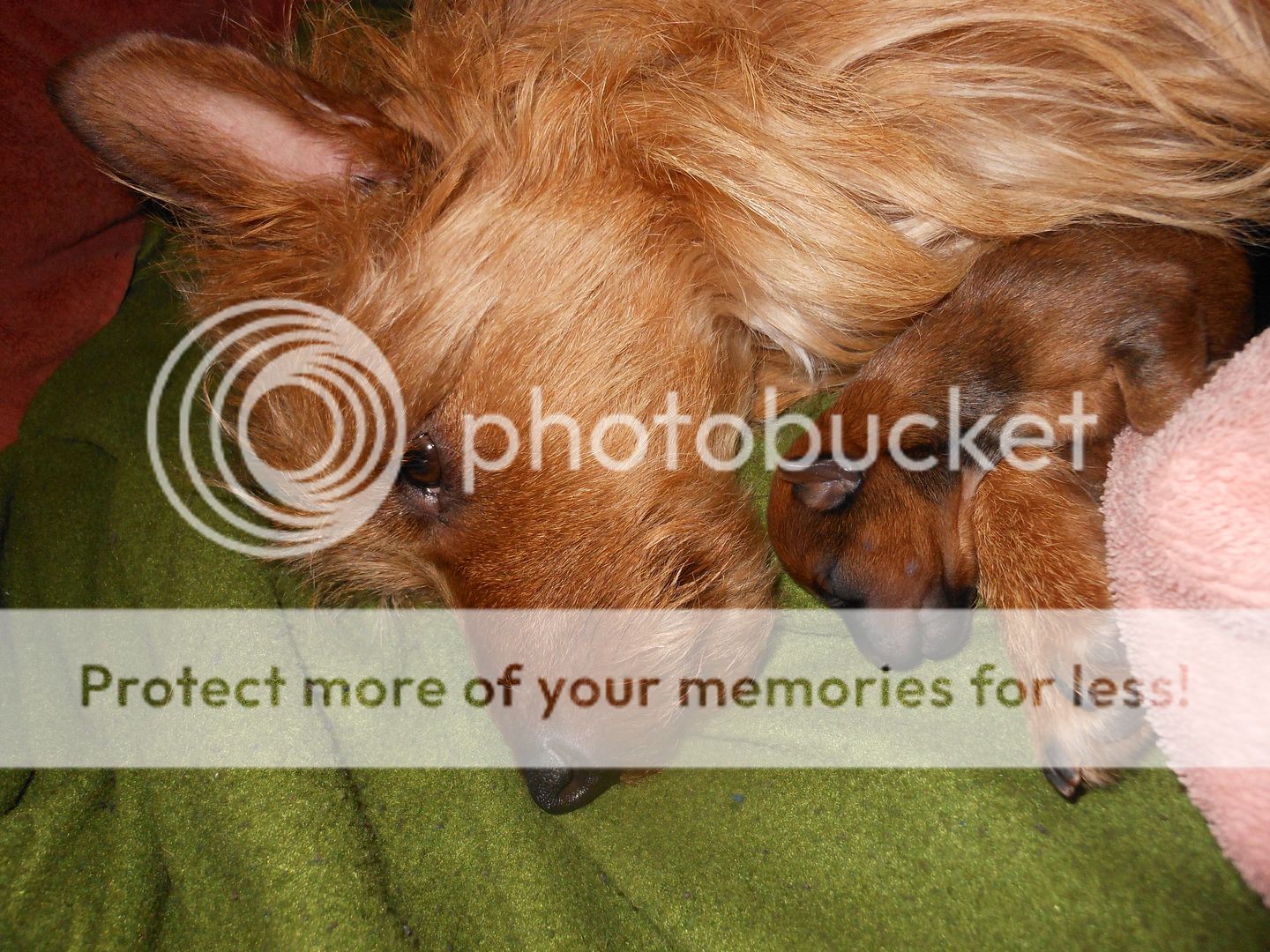
Fergie and her puppy.
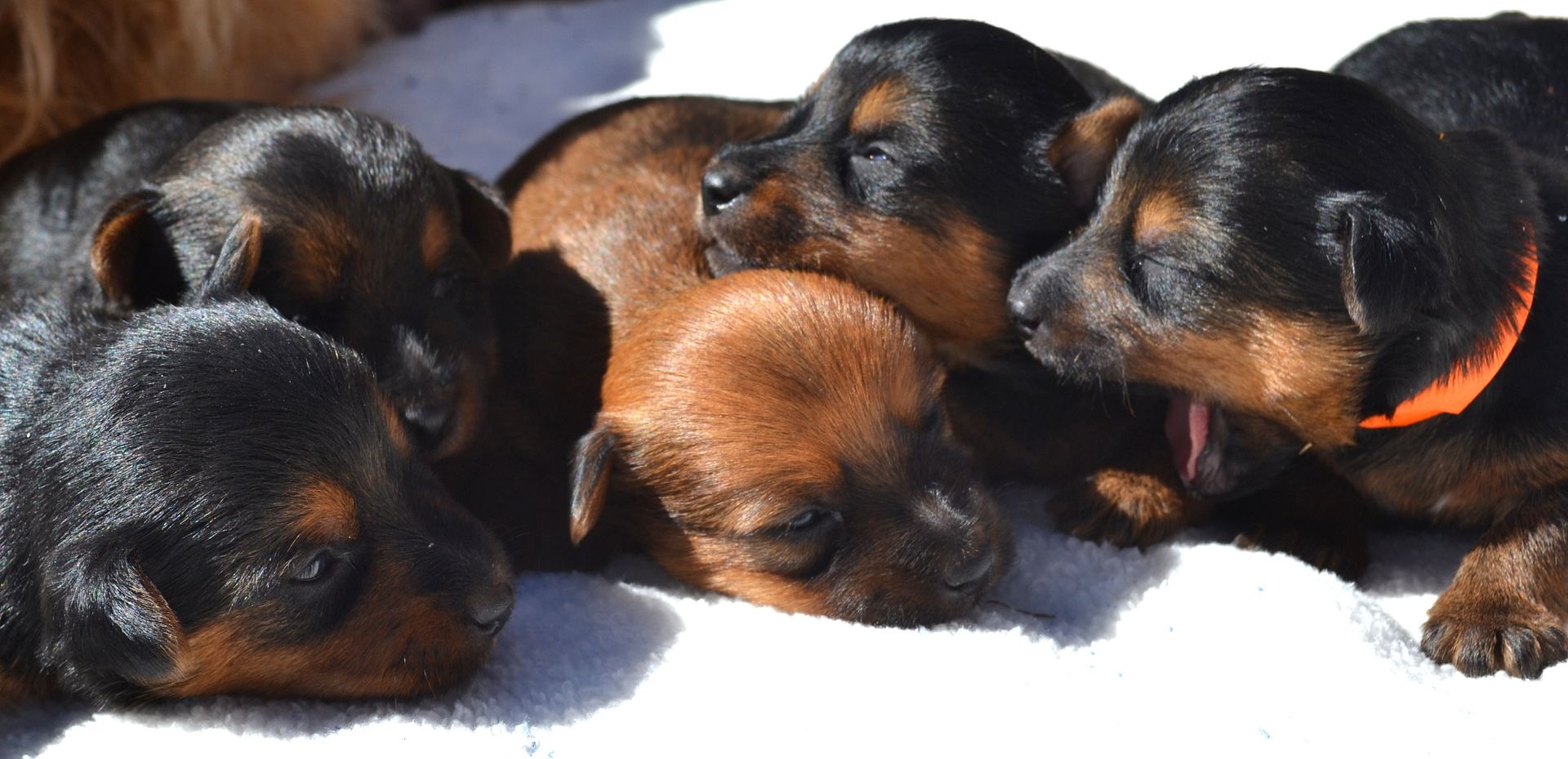
The puppies in a puppy huddle.
To date, the cost of this endeavor is somewhere around $6000.00 to $7000.00. I did this for the betterment of the breed. Although it probably will take generations of Aussies to see if the impact of this wild tale was worth it, I am ever hopeful.
April

Puppies are growing and enjoying running through the agility tunnel all together.
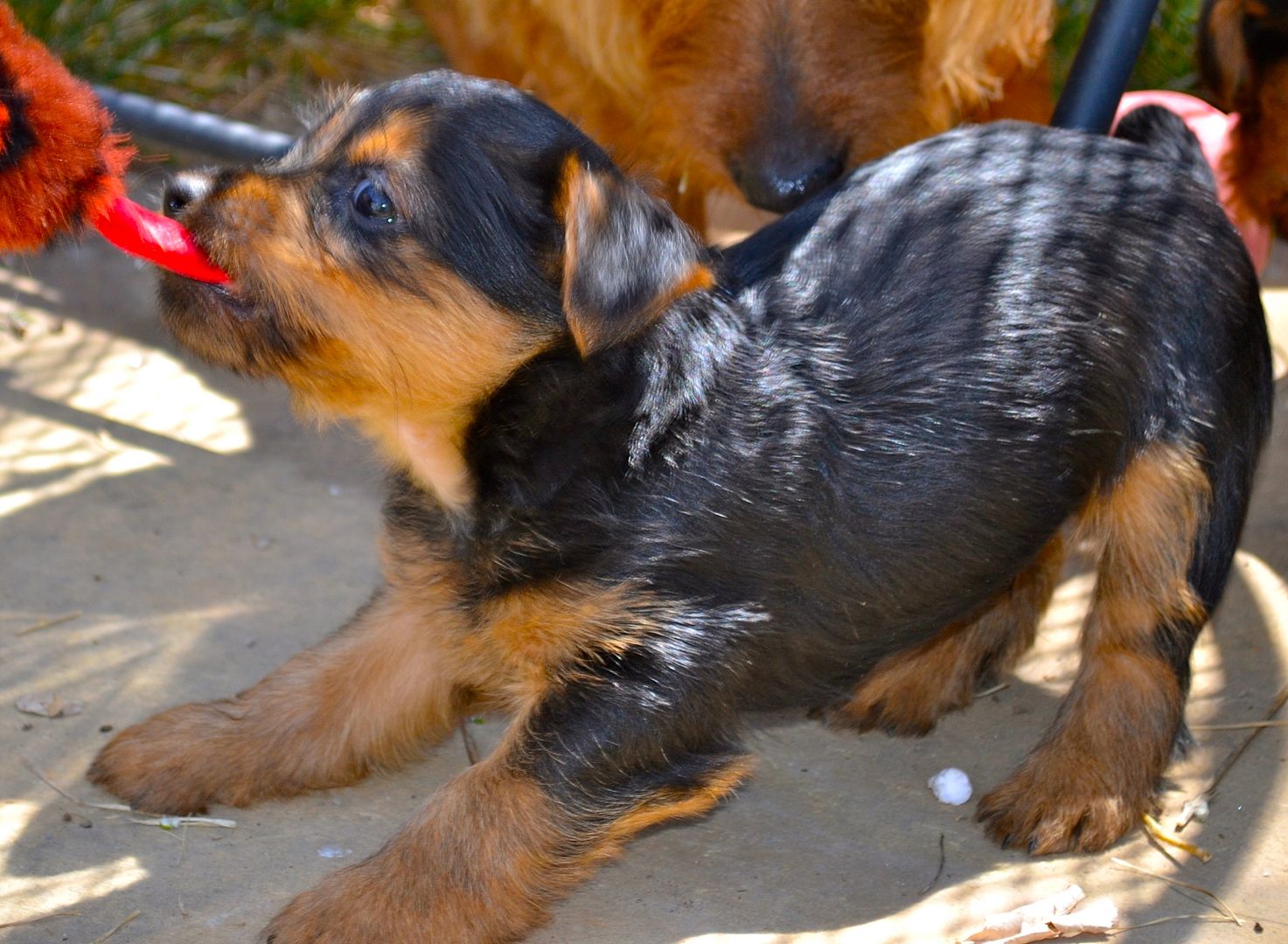
Playing tug-of-war.
The History Of The Docked Tail
This article was written and presented by Sue Holsinger, at the request of the ATCA President, in 2009, at our National Specialty. As such, some of the information, as presented, may be out of date.
The origins of tail docking are varied and contradictory. The first references go back to Roman times, when dogs’ tails and parts of their tongues were cut off to prevent rabies. In Europe, aristocratic families often had hunting dogs. At first, hunters decided a shortened tail would help the dog with its quickness and agility. This trend became so popular that noble landlords began taxing the owners of long-tailed dogs.
Tail docking seems to have emerged for a variety of reasons, but for some breeds it was proposed primarily to improve appearance. Books from different periods openly refer to docking of some breeds as a matter of pleasing appearance (e.g., The American Book of the Dog, 1891, p. 619, 6695; 6696).
AKC has taken the position that, “In the case of new breeds, if the breed is cropped or docked, they are required to describe a natural tail. This would include the Glenn of Imaal Terrier and the Black Russian Terrier, Pyrenean Shepherd, Swedish Vallhund. Standards that have recently been revised to address natural tails are: The Clumber Spaniel and the Affenpinscher.”
The American Veterinary Association has held a position against ear cropping since 1976. Tail docking was added to their position statement in 1999. They strengthened their position in the end of 2008 to read:
“The AVMA opposes ear cropping and tail docking of dogs when done solely for cosmetic purposes. The AVMA encourages the elimination of ear cropping and tail docking from breed standards. ”
Legislation in the US falls into 2 general categories. First there are stand-alone bills, which seek to ban cropping and docking. Then there are care and conditions bills, which would require cropping and docking to be done by a licensed veterinarian and address a group of medical procedures including debarking and cesarean sections. These later bills are designed to prevent puppy mills from performing procedures in an inhumane manner, but also to legislate hobby breeders. There are currently cropping/docking bills in New York and Illinois, and some 30 care and conditions bills across the US.
Worldwide, cropping and docking has been outlawed in the following countries:
England, Wales, Scotland, Australia, Sweden, Finland, Norway, Denmark, Germany, Switzerland, Cypress, Greece and Luxembourg.
Some countries have exclusions for hunting dogs or dogs of specific breeds, but overall these are limited and require an excessive burden of proof. Several of these passed initial legislation that required that cropping and docking be done by a veterinarian, then followed with an outright ban or deemed it unethical for veterinarians to do it.
Breed Standards in the US describing natural tails include the Affenpinscher,Clumber Spaniel, Glen of Imaal Terrier, Swedish Valhund, Black Russian Terrierand Pyrenean Shepherd. Fifty-five breed standards mention docking. Thirty-seven specify the dog should be docked with ONLY ONE identifying a tail not docked as a fault.
Breed Standards abroad still dance around the docking issue. Many breeds have not rewritten their breed standards since docking bans took effect. Australian Terrier breed standards in some countries reflect this. The UK has added language indicating that the tail was previously customarily docked, and New South Wales indicates that dogs with natural tails were permitted to be shown. Scandinavian countries wait for the Australians to revise their standards. Only the Australian Silky Terrier standard seems to have addressed the issue, and states:
Tail: Preferably docked, set on high and carried erect but not over-gay. Should be free of feathering. If undocked, the first three vertebrae to be carried erect, the balance to be carried erect or slightly curved, but not over-gay. Must not be curled. The length to give an overall balanced appearance. In accordance with the docked description the undocked tail to be free of feathering.
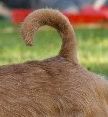
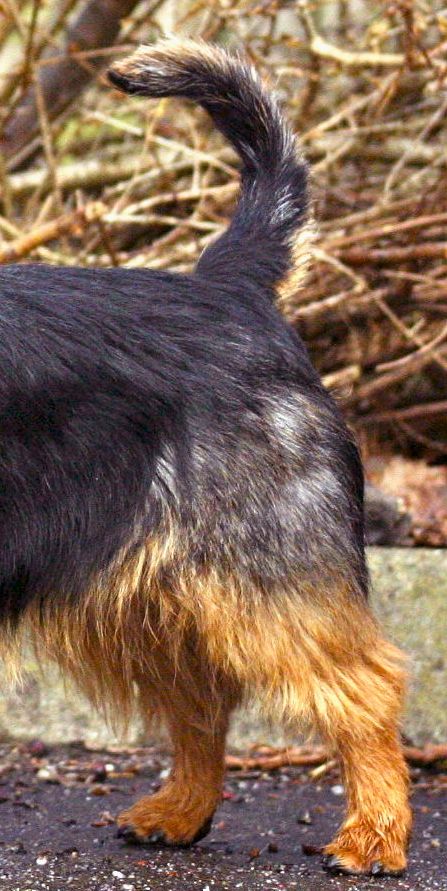
In light of the bans on cropping and docking abroad, and the volume of legislation in this country that would restrict or prohibit the rights of breeders to dock puppies, I think it is prudent to consider the future of docking in our breed. Allowing for undocked dogs to be imported and shown without penalty enhances our ability to breed for an attractive, undocked tail, and enlarges our gene pool. Sue Holsinger
Puppy Buyer Contracts By Theresa Goiffon
Most reputable breeders provide puppy buyers with a contract at the time of purchase. Here are several things you may expect to see in your contract.
Breeders and new puppy owners both want the same thing, a healthy, happy puppy. Mutually agreeing on what is in the best interest of the puppy is important. Putting your agreement in writing is important for all parties involved in order to avoid any misunderstanding. I spoke with several Australian Terrier breeders across the country and abroad regarding this topic. Do they have a contract when they sell a puppy? Does their contract only apply to show homes or to companion homes as well? Here is what I discovered.
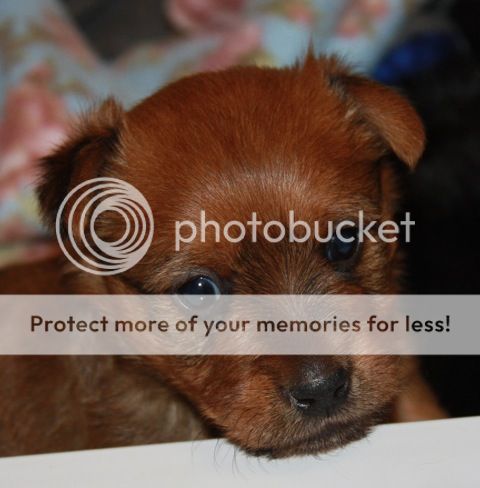
Photo Courtesy Of Pamela Levy
All of the breeders I spoke with have contracts. A contract for show/breeding Aussies is different from a contract for a pet/companion. Although much of the same general agreement is used in both, the show/breeding contracts often require co-ownership with the breeder and more specific conditions are required of the buyer by the breeder.
Most contracts include the obvious conditions, such as making sure the puppy is not tied or chained outdoors or kenneled extensively. Most include making sure the puppy is provided with a safe play area, with fresh food and water daily. Puppy contracts also require that routine veterinary care, in addition to following the vaccination protocol provided by the breeder, be provided by the buyer.
Some breeders provide a health guarantee; some do not. Many breeders perform health tests on the parents of the puppy and provide the results to the new owner as part of their commitment to breeding only healthy dogs.
Many include in their contract that the puppy buyer agrees to participate in providing information for health surveys and longevity surveys as well.
Breeders stipulate at the time of this sale that the puppy is to be a pet/companion puppy and that they register their puppy with the American Kennel Club. The privileges with the AKC will be on a limited registration basis, meaning they are not allowed to breed their dog.
Most contracts state the puppy is to be spayed or neutered prior to nine months of age and that the puppy will not be allowed to breed or be bred for any reason. If breeding occurs, the puppy and all resulting offspring are to be returned to the breeder.
Some breeders require the buyer to have their puppies micro-chipped.
Some countries, like Sweden, have both direct purchase agreements for companion Aussies and co-owner purchase agreements which include breeding rights. Thank you to Ewa Karlsson for providing me with a copy of The Swedish Kennel Club (SKK) Dog Purchase Agreement, one with and without breeding rights retained.
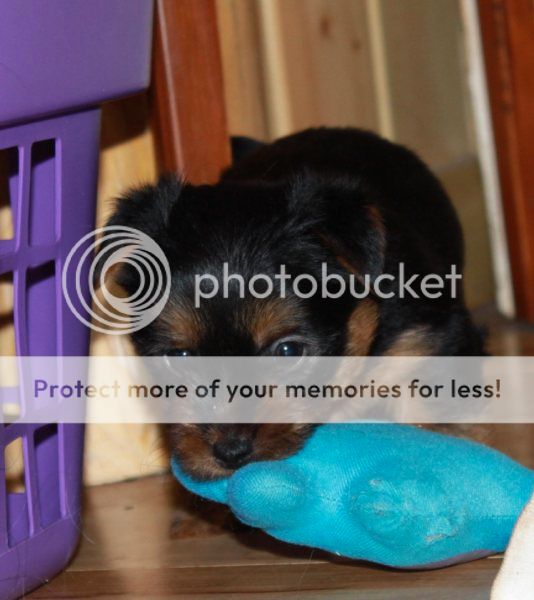
Photo Courtesy Of Theresa Goiffon
Most of their requirements are not much different than the US agreements. Something that I have not seen in the US breeder’s contract is the requirement for insurance. The SKK requires that all puppies be insured and specifically states that the breeder has taken out insurance to cover hidden faults. This insurance is valid for at least three years from the day on which the dog is delivered. The insurance amount corresponds to the purchase price.
The buyer agrees to purchase life and veterinary care insurance for the dog. The insurance amount may not be lower than the purchase price of the puppy. The buyer agrees to pay the premiums for this policy without delay and to maintain the policy for at least three years once the puppy leaves the breeder and is registered with the SKK. In Sweden, most breeders require the new owner to provide them with the results of health testing, which are eyes and knee (Patella) at the age of one year.
Both pet/companion and show/breeding contracts, both here and oversees, are very specific about requiring, should the new owner no longer be able to care for the dog over the life time of the dog that the dog be returned to the breeder for re-homing. In some instances where travel makes returning the dog difficult, the breeder and the new owner will agree on a new home for the dog.
The reasons for a contract are fairly self explanatory. Every breeder wants to make sure the dogs they help bring into this world are in the best forever homes. The written contract provides a clear expectation and understanding between both parties.
The Story of Tippe Kennels
Tippe is the oldest active Australian Terrier breeding kennel in Denmark. Founded in 1975, Tippe looks forward to celebrating their 40 year anniversary in 2015. I have been fortunate to be a part of Tippe Kennel from the start.
It all started in 1967 when my mother, Birte Lillian Steffensen, bought what was according to the ad, a German Shepherd in a small body. My mother’s parents had several German Shepherds when she was a child. In 1967 my parents lived in an apartment so of course a mini-German Shepherd was the dog for her! But Ravnegårds Apilak (Totte),of course, was not a mini-German Shepherd. He was the first Aussie in our home and a true great “big brother” to me. I was born in 1968 and I was practically born in a dog basket as Totte lay under my mother’s bed during my birth. I was introduced to him when I was 30 minutes old.
In 1973 we bought Ravnegårds Nefertite (Tippe) and named the kennel after her. She became a Danish champion and the mother of our very fine line of bitches. Our breeding was an unbroken line from 1973 to 1996 when my mother chose to put the breeding on hold for a while. She did this because during the 90’s she became a FCI show judge for all the terrier breeds. She was judging increasingly at international shows both in Denmark and abroad.
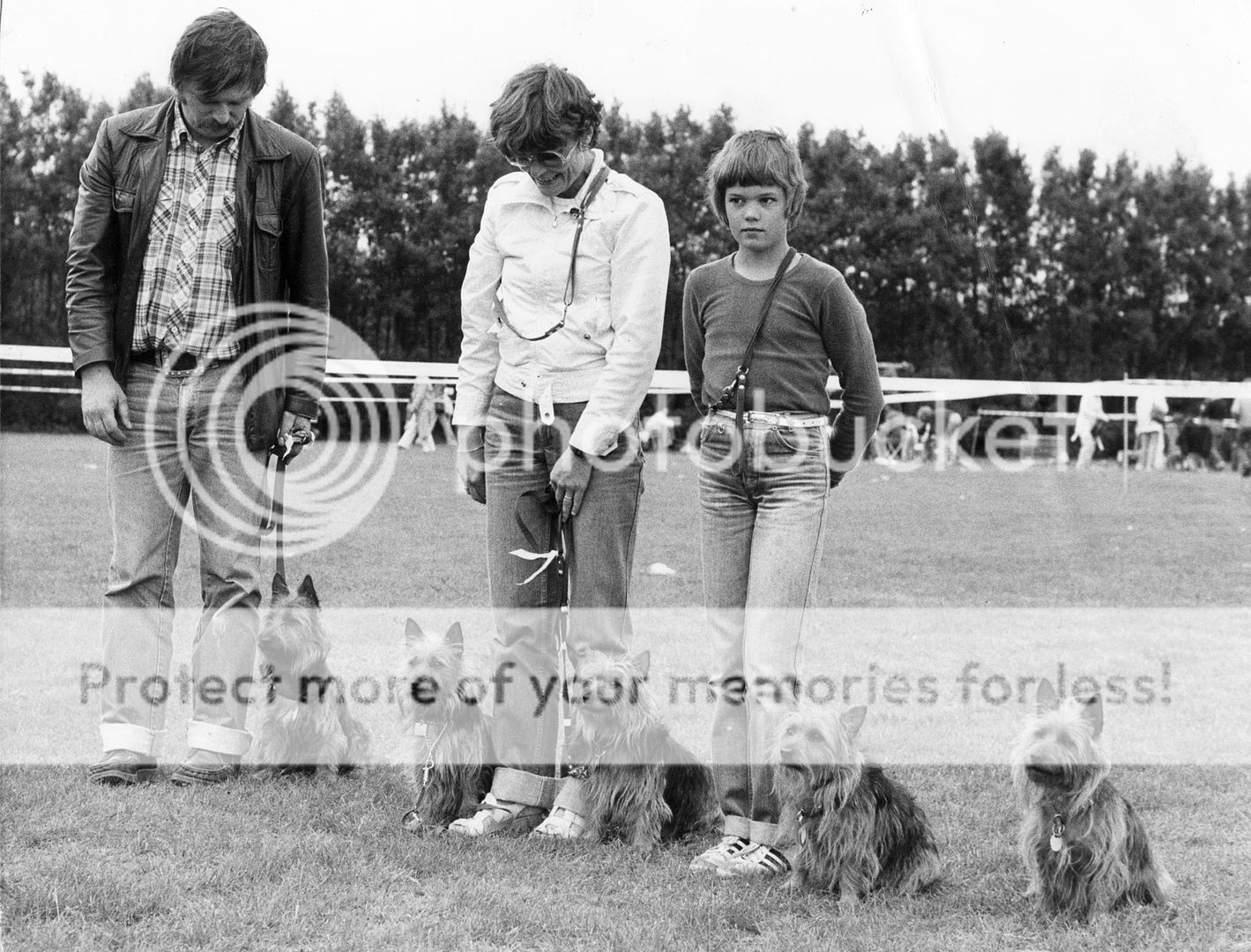
1981: Four generations in a kind of “progeny-obedience-class” of Aussies from Kennel Tippe, Denmark. From the left: Arne Sørensen with DKCH NLCH INTCH VV85 WA82 WA83 BDSG WA85 Tippes el Gordito, his litter-sister DKCH VV85 INTCH KBHV83 WA83 Tippes Esta Divina de Chica, my mother, Birte L Steffensen (founder of Kennel Tippe) with their mother: DKCH Tippes Blue Chica and me with my first dog, the mother of Chica: Tippes Bluegirl and her mother: Tippes Aisha.
Tippe’s first litter produced Aisha who was amazing at assessing people and a very sound and capable leader of our four generation pack of bitches living at home. She was also an incredible obedience dog, passing the Danish Kennel Club’s obedience classes I and II earning first place prizes. She also was the mother of my first dog, Bluegirl (Blubbe) who like her mother was an excellent obedience dog. She was our second generation to also pass the Danish Kennel Club’s obedience classes I and II. Blubbe was no show beauty but she produced Tippe Kennel’s first homebred Danish champion and our third generation in a straight line, DKCH Tippes Blue Chica.
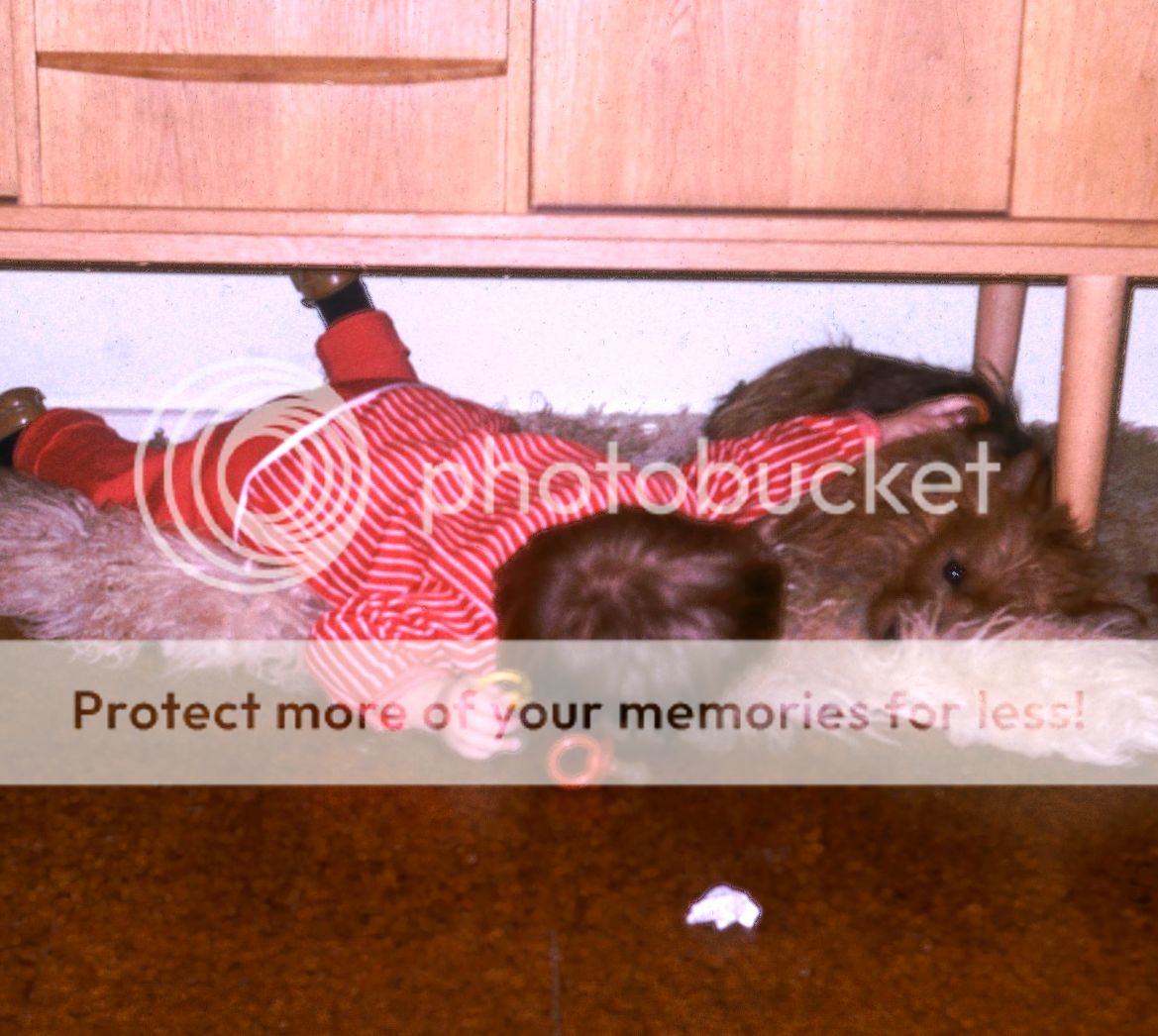
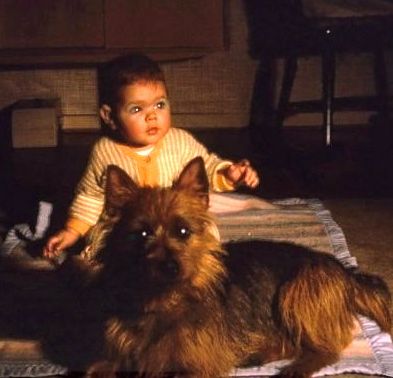
1969 Totte and Vibeke
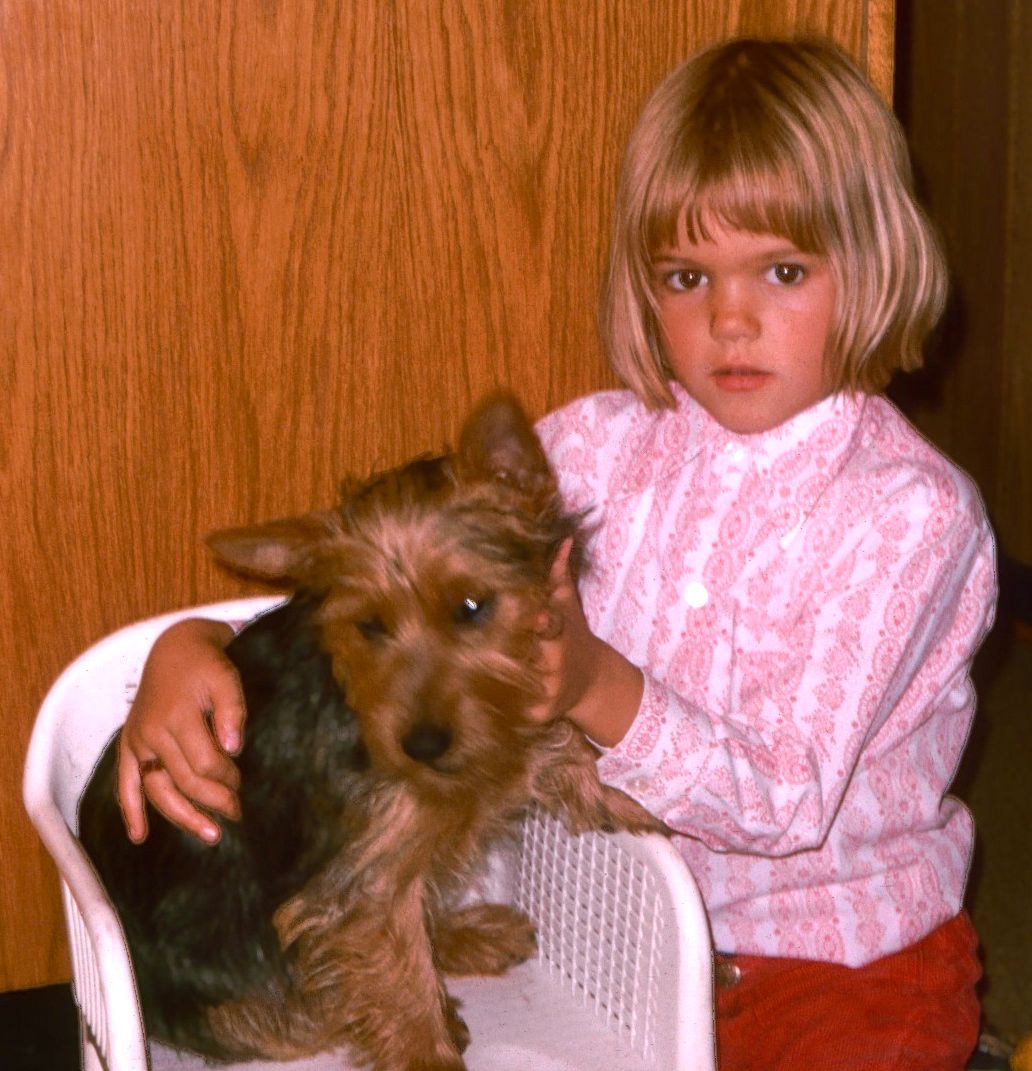
1974 Tippes Aisha and Vibeke
Møffe mothered our fifth generation giving me my second bitch, the red Tippes Lindeza Roja Divina (Jubii). Jubii was a very special dog for two reasons: she was the first Danish bred red Aussie to become a Danish champion and, in 1996 at the age of 12 years, she became the Best Aussie Bitch of the Year and the fourth Best Aussie of the Year in overall competition. She did this by being placed 1-4 in competition of Best of Breed at all of the shows she attended throughout the year!
Jubii’s red daughter, DKCH Tippes Princesa Roja Divina (Así), was our sixth generation at home and our fourth generation of champions in a row at home. She produced three litters and from her last litter in 1995 we kept Tippes Te Quiero Tanto Divina (Tante). She was the seventh generation and the last bitch we kept from our line of bitches, a straight line that led back to Tippe and 1973.
From the beginning, Tippe Kennels has been true to the classic Aussie type. From the third litter of DKCH Tippes Blue Chica and onwards, we have had at least one champion from every litter. In several litters there also have been dogs who passed various obedience classes in different countries. We never have had more than four bitches at home, one from each generation, and that makes the high number of Tippe champions even more remarkable.

1970-1971 Learning to Groom.
The very best, however, are all of the lovely responses from our puppy buyers that we have received over the years telling us what wonderful four-legged family members they have had for a number of years. Many former owners return to Tippe Kennels for their second dog or for another dog after losing their old Aussie. To me, this is proof of the high quality in our dogs and proof of the pride we take in choosing the best quality dogs for our breeding program. Since 1975 producing true Aussie-type, sound dogs with a serious breeding program remains the trademark of Tippe Kennels.
Our kennel marked the beginning of a new era in 2011 but I have the same requirements for good health as my mother and I take breeding equally serious. Therefore, the parents of my new line of bitches have been chosen very carefully. Both parents are of the same good type that has always been the trademark of Tippe Kennels: the classic Aussie. So these top-winning dogs, DKCH LUCH DECH DEVDHCH KLBCH INTCH Surely Nothing To Lose “Silja” and SECH NOCH DKCH INTCH Pariservikens Earth Boy “Gizmo” are the parents of my U-litter and my new rising stars.
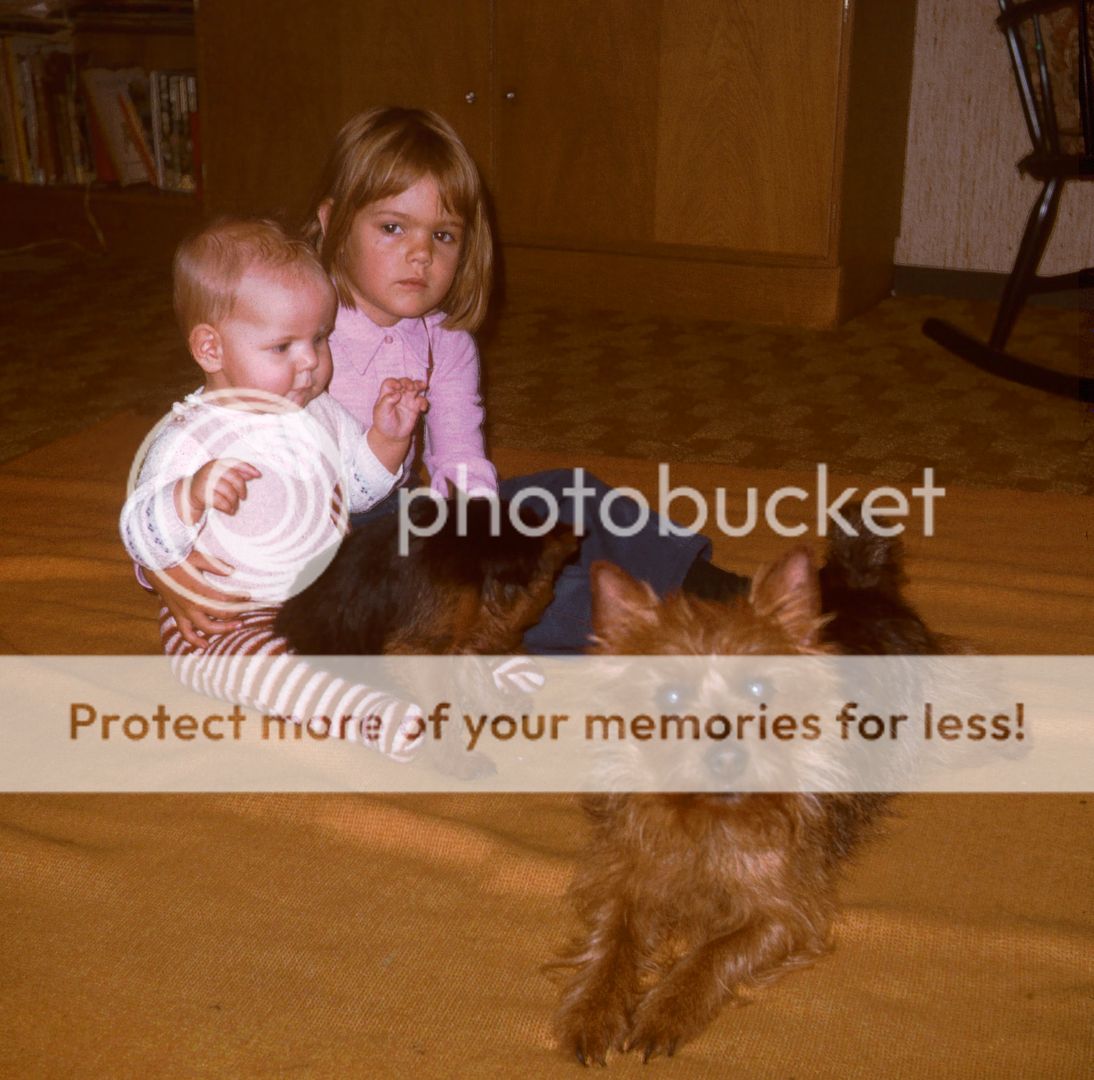
1973 My little sister (aprox 8 months) and myself (5 years) with Totte (6) and Tippe Kennels stemmother Ravnegaard Nefertite Tip.

I grew up with Australian Terriers and I love the classic Aussie which is the basis for the standard in the FCI. It describes a rough and persevering little working terrier with a harsh, weather-proof coat. It adds that they are brave, courageous, independent and watchful little dogs being incredibly loving, playful and curious pets who love being with children, adults and other dogs.
All breeds evolve over time as they should, but in my opinion the Aussie has moved away from the original type of Aussie. I aim to steer the breed back in the direction of the classic Aussie. The Australian Terrier lives within my heart. They have always been a part of my life right from the day I was born. I am passionate about improving the quality of the breed I love. That is why the most important thing for me in my breeding program is that my bitches and males used for breeding are mentally and physically sound. The “wrapping” must be nice, but it is the inside of the dog that a family lives with.
My dogs here at Tippe Kennels are part of our family and they live inside the house with us. They cuddle next to us on the couch and share all aspects of our life. My litters grow up in the living room so they are acclimated to the sounds and noises of a “normal” family from the start. They are handled and played with by both children and adults on a daily basis and are with the other pets in our family. As soon as the puppies are old enough they go outside on discovery tours. This is a part of the socialization that is so important for the dog to be able to live among people as well as other animals.
After many years without puppies, Tippe Kennels is back in business and I will do my utmost to live up to the high quality Aussies that my mother was so well known for with her breeding program. Her motto was, “Tippe Aussies-obedient dogs with a great appearance!” I will continue her serious breeding program with my motto: Tippe Aussies: Healthy pet-dogs with a great appearance!
To View More Historical Photos Click Here
Tippe Kennels by/Vibeke R. Christensen, Brogaardsvej 3, DK-8362 Hørning,
Phone.: +45 87 68 00 02, Email: kennel.tippe@yahoo.com
http://www.kenneltippe@dk/
Buyer Beware Written By Lynn Hahn
My goal in writing this story is to share information that will open Australian Terrier breeders’ eyes as to how their breeding methods affect the breed and the people who purchase their dogs. I hope my story influences the decisions a breeder makes when breeding a dog that has produced puppies with genetic problems. Perfection does not exist. Genetic imperfections will happen. It’s the action taken after the occurrence that matters. Those actions affect the breed and the individuals who purchase Australian Terrier puppies.
Prior to getting my Australian Terrier, Betty, I had some good and bad experiences with other dog breeds. My mother raised Collies for a short time when I was really young. She bred a small number of litters. All were healthy except one pup. He ironically lost an eye. That was a very long time ago but I believe it was not genetic but from an accident. My mother had the puppy’s eye removed then gave our one eyed pup, Sparky, to our paperboy. My experience with my mother’s Collies was very good.
As an adult I have owned a few different breeds. My first breed was a Cairn Terrier. I adopted her, in a manner of speaking. She was being abusively tossed back and forth like a football by a group of boys. I grabbed her and ran away with her. No one came back to claim her. She was wonderful. She was healthy, intelligent and loyal.
My son was only a year old when we purchased “the doggie in the window” for him. We saw our Border Collie mix at a pet store. My son fell in love with her so she went home with us. She too was healthy until late in life when she developed colon cancer.
Our next group of dogs was Yorkshire Terriers. We bought three of them over a three-year period. All of them had the same father but different mothers. All had health issues from bad breeding practices. Our youngest, Joe, topped out at two pounds. We lost him at seven years of age when his organs outgrew his body. Our second boy, Andy, was born with an oversized heart, liver issues, pegs instead of teeth and a very underdeveloped jaw. He was not expected to live past four but lived to be ten. We still have our oldest Yorkshire Terrier, Bob, who has mental issues. He is on the medication Reconcile.
When Joe passed our middle boy, Andy, was lost without him. He and Joe were inseparable. I wanted to get him another buddy. Our oldest Yorkshire, Bob, has no interest in other dogs. My husband wanted more Yorkshires. I did not. I was afraid of the health issues. We were at a festival one afternoon and saw a dog that resembled a Yorkshire. It was an Australian Terrier. My quest for finding an Australian Terrier began that day.
It was not easy finding a breeder. I went online looking. There was only one breeder I found close to my state. I called her. She is listed in Idaho but resides in Washington where I live as well. She was going to the airport in Seattle to deliver a puppy to a client. We agreed to meet at a mall close to the airport so I could see examples of her line of Australian Terriers.
I fell in love with the breed. Her dogs had lots of energy and were very loving. After I visited with her dogs we began talking about my time line in getting a dog. I was thinking of waiting about six months and was very clear about my need for a healthy dog. I shared that I have taken care of dogs born with health issues for the past 12 years. I needed a break. I wanted a sound puppy.
The breeder told me that was unfortunate because she had a little girl that needed a home. She said she had one eye that was smaller than the other making her difficult to sell. Her story touched my heart. I asked if the puppy’s eyesight was affected and if the size of the eye was all that was wrong. She said yes her eye is functional just smaller. She said the puppy has some discharge but she would outgrow that. The mother had another puppy with the same issues in another litter and the puppy outgrew the discharge problem. I agreed to travel to Spokane to meet her puppy.
The breeder brought Betty to the hotel where I was staying. It was love at first sight. I had to buy this sweet Australian Terrier. Getting a puppy is emotional for me. When I fall in love with a dog it is deep. My thinking gets a bit foggy. I saw that her eye was smaller than the other, which made me love her even more. She hugged me with her arms when I picked her up. It was clearly love at first sight for her too.
The breeder sold her for a discount due to her eye. The breeder pointed out the hand written comment on her contract,” Buyer recognizes this puppy has a smaller eye than normal right eye which may require extra care.” Since we had discussed her eye and she assured me it was not going to be a problem I was comfortable signing her contract. I did not fully read the contract before I signed it. Not a wise thing to do but I had no intentions of ever letting go of my new little girl.

After I got home with Betty I was concerned because the mucous in her eye was green and Betty was clearly in discomfort. I took her to my vet for her puppy check up. My vet thought she had entropion. She said it was possible she would outgrow it but we needed to keep an eye on it. My vet also said Betty may have patella issues but it would be easier to determine when she was older. Betty was 12 weeks old.
I called the breeder about the possibility of Betty having entropion. I told her how much pain Betty was in. She said Betty would outgrow it. She told me to just keep her comfortable until she did outgrow the condition. I asked her if Betty was in pain before I got her. She did not answer my question but again told me Betty would outgrow this condition.
Entropion is a medical condition where the eyelid, usually the lower one, folds inward and the eyelashes irritate the eye. It can be very painful as the eyelashes can actually rub against the cornea. The literature says it is usually caused by genetic factors and may be congenital.
Betty’s eye was causing her so much pain. She would tilt her head and shake it while walking. She kept her eye closed most of the time. I was constantly cleaning green mucous out of it. Watching such a sweet puppy in so much pain was wrenching. I went back to my vet. She said we should do surgery for the entropion. My vet was concerned her cornea could be damaged.
I contacted the breeder again. I told her Betty was in too much pain not to address this. The surgery was not invasive. A small section of her lower lid would be removed and the area sutured reshaping her lower lid so hair was not in her eye irritating it. Her lower lid folded inward. The breeder told me she would suggest waiting but to do what I needed to do.
I felt very alone with this situation. The breeder never called me to see how we were doing. She did answer my emails. She did talk to me on the phone when I called her. She was pleasant and expressed sorrow for my situation but did not reach out to help me. I struggled to believe the breeder was not aware of the pain Betty was in prior to selling her to me. I began to think perhaps she had not spent time with Betty. That would be the only way she would not be aware of Betty’s pain.
I went in and out of anger toward the breeder. I felt she had mislead me but then realized had she not mislead me I would not have Betty. I never would have come to see her. Then I would wonder what would have happened to Betty if I had not taken her. I went round and round in my brain trying to figure it out. I realize that was a waste of time but I was truly taken aback by the whole situation.
Betty had entropion surgery when she was four months old. Sadly, the surgery did not help her. She was still in horrible pain. My vet gave her some pain medicine but it did not seem to help. She dilated her eye to relieve the pain. That was very tough. I had to be careful when she went outside due to her eye being dilated. The dilation made her eye worse. I was feeling so helpless. I could not find a way to stop my little girl’s pain.
When we were at our second home in Wenatchee, Washington, I took her to our vet at that location. This was his first meeting with Betty. He was very alarmed by the amount of pain Betty’s eye was causing her. He wanted me to take her to Dr Sullivan, who is a specialist in Seattle, to assess her eye.
When we got back home I again took her to my vet. She also suggested that I see Dr Sullivan. He is a much respected animal eye specialist. Dr Sullivan took one look at her and said she has no moisture on the right side of her face. He told me to look at her nose. It was dry. He pointed out the asymmetrical condition on the right side of her face. It was sunken. He tested the moisture in her right eye. There was no moisture. He explained how much pain she was in. Can you imagine having sandpaper in your eye? He told me that was what she was feeling. Her diagnosis was Congenital Microphthalmos/Xerosis.
We talked about several options but Dr Sullivan said they all may lessen her pain but not take it away. All of the dogs he did alternative care on ended up having their eye removed. After removing their eye the dogs were free of pain and happy. I asked if that would be the best choice for Betty. He said if it were his dog he would remove her eye and let her be free of pain.
Dr Sullivan suggested an implant be placed to prevent the area from sinking and to help with healing. We paid the extra fee to include an implant.
I was taken aback when I picked Betty up after the surgery. Her eye was so swollen. I did not want to let her see how upset I was. She was very drugged up. When I got home I put her in her kennel, went into the bathroom, got in the shower and cried so hard I thought I would stop breathing. I was so in love with her. Seeing her like this broke my heart.
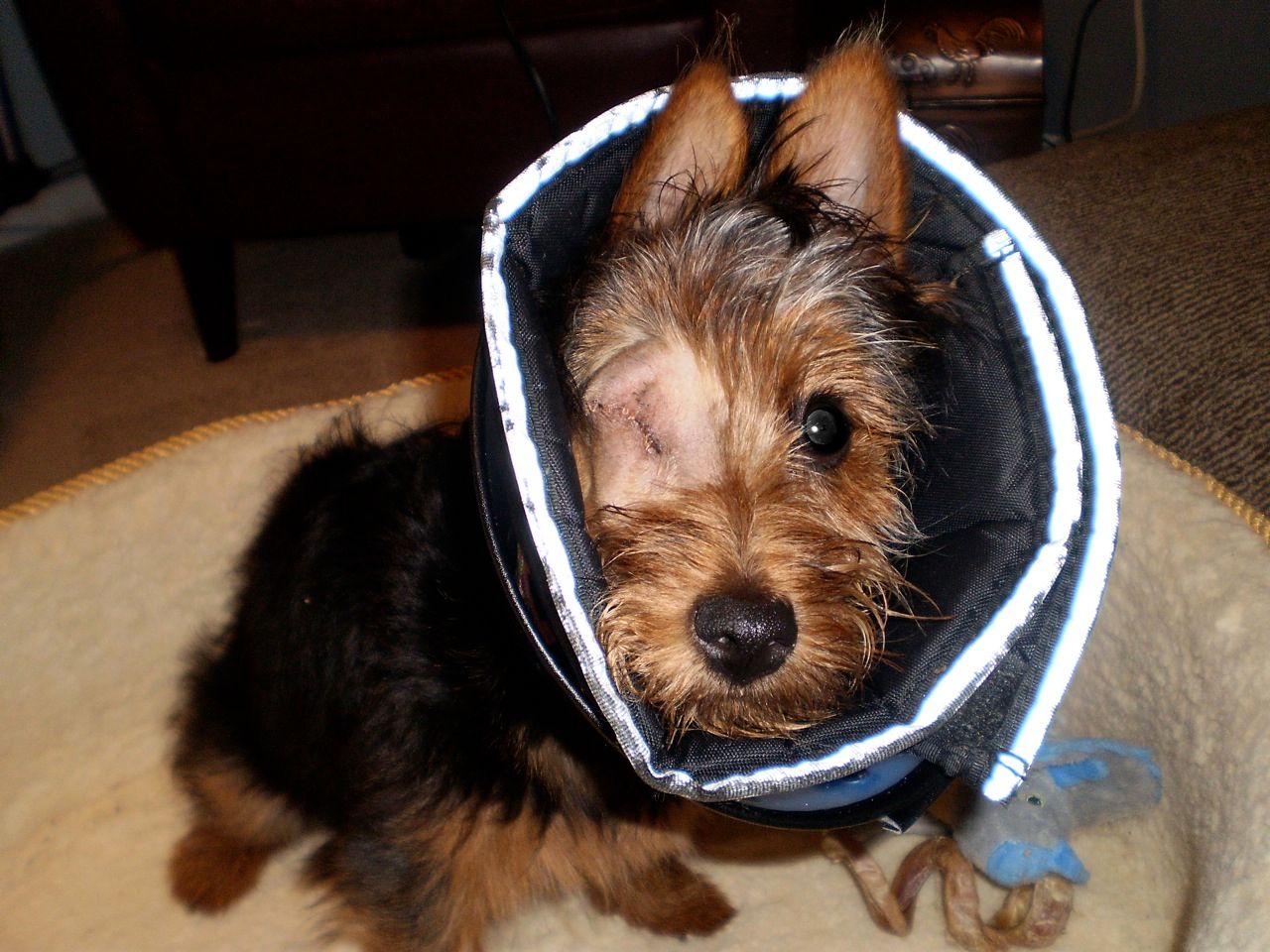
Betty was back to wearing her protective cone. She had worn a cone for three weeks after her first surgery. This time it would be six weeks. Betty was only five months old when she had her eye removed. Her life so far was nothing but pain. She remained so sweet. Even the doctors remarked on her amazing temperament.
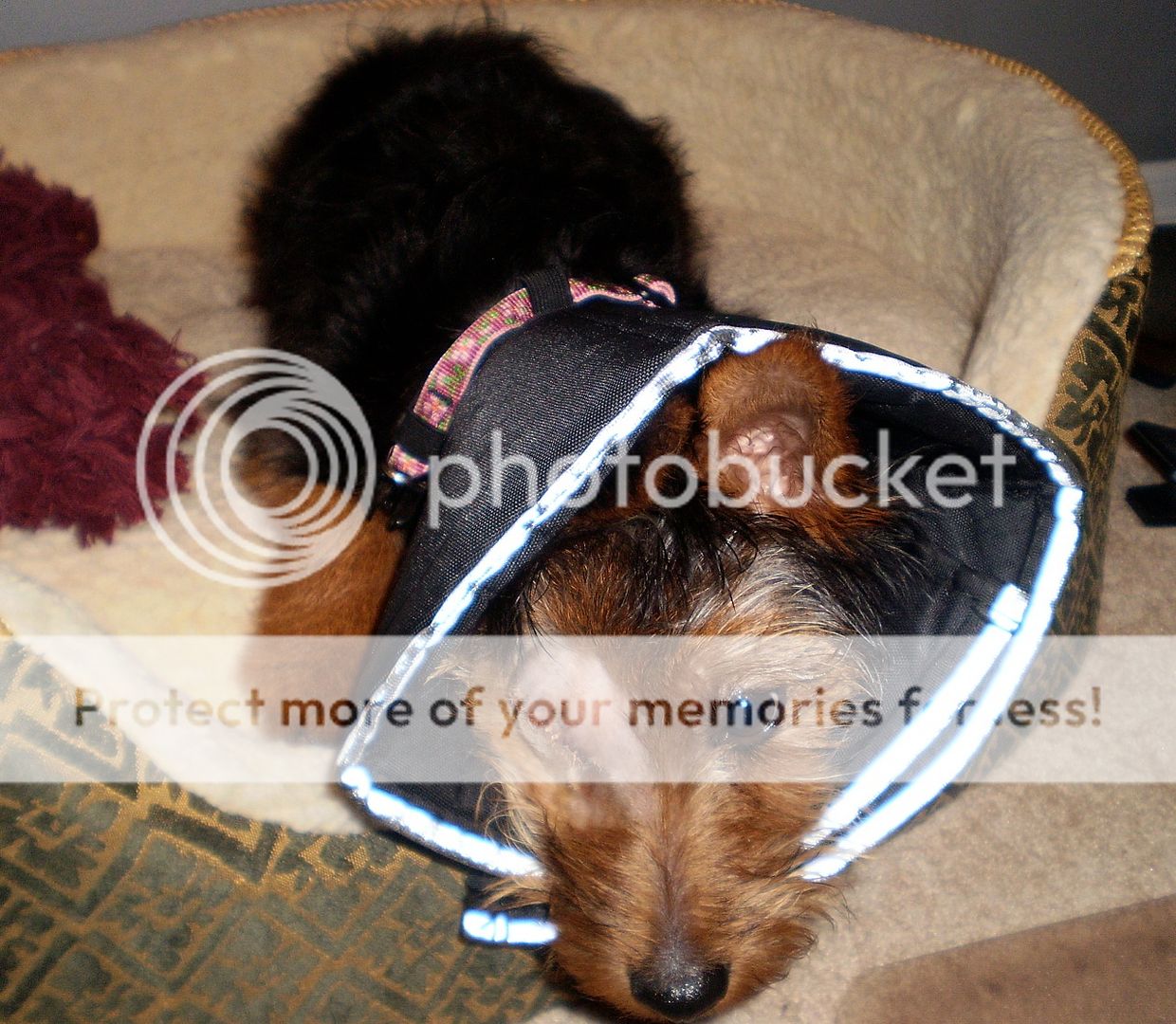
The recovery was very difficult. She was use to being in pain so keeping her still was extremely hard. I’m sure it was just a different kind of pain for her. She became frightened of the dark and began barking out of fear. I’m sure not being able to see out of her right eye was disarming. She had always followed me around the house but now she could not be away from me without becoming highly distressed.
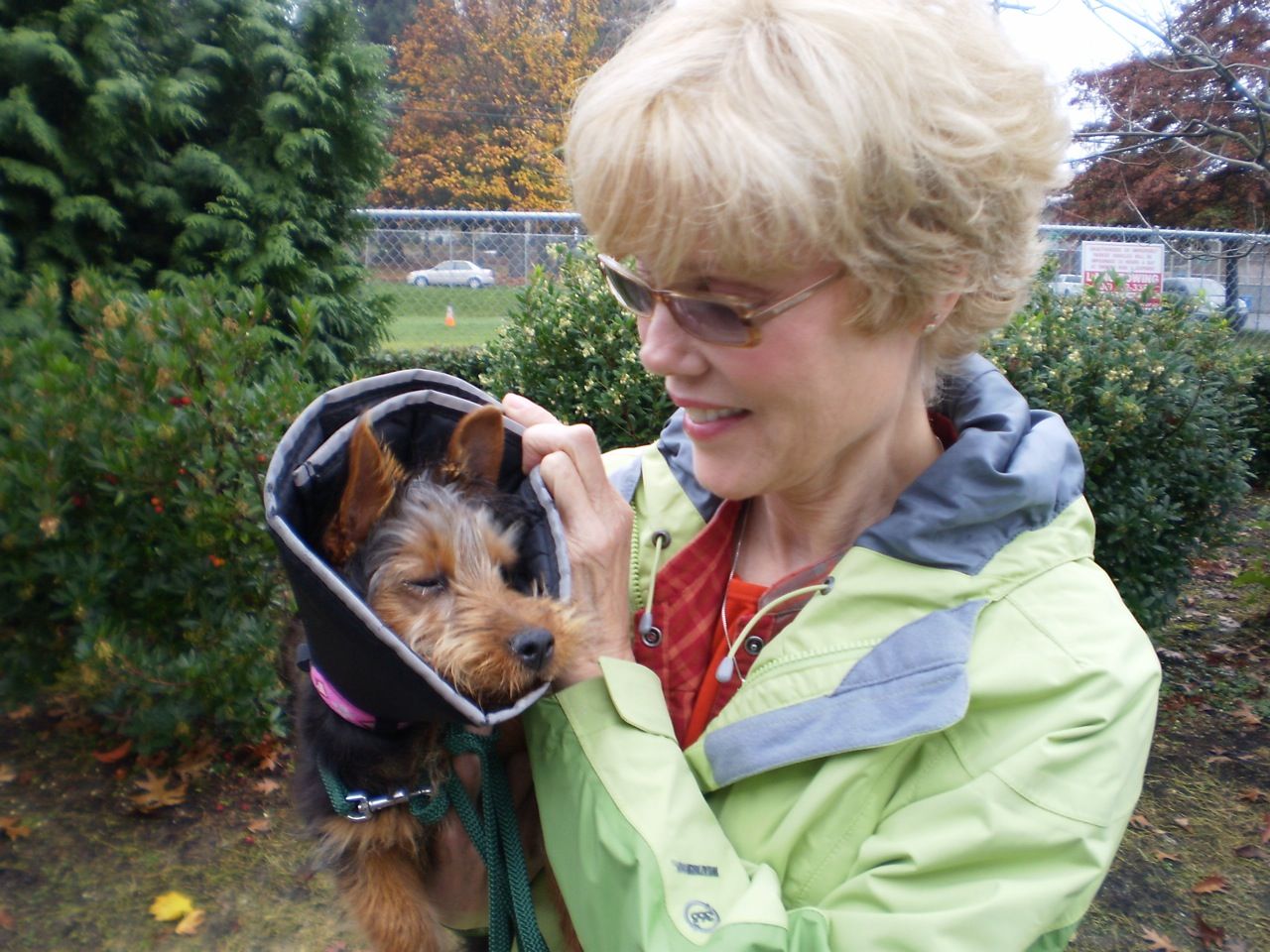
We did make it through the six weeks. Now it was time for her to be spayed so another surgery. She was six and a half months old when she was spayed, thus another two weeks in her cone. But it would be her last time in the cone. That is what I told her and myself so we could get through the two weeks. I told her all the wonderful things we would be doing. I’m sure she did not understand my words but she could feel my excitement and joy. She, too, got happy despite her discomfort.
Once Betty was able to become active her knee started to show signs of issues. Her right knee popped out several times when she was running hard making her cry from pain. I thought OH NO not another problem! She was able to get her knee back in place but was clearly in discomfort. I took her to my vet. She said if this kept happening it would be wise to see a specialist.

It was suggested by a vet in Las Vegas that Betty should be checked before considering agility. She had loose patella in both knees. I thought it was just her right knee but he made it clear that both knees were affected.
I was very upset. I sent the breeder an email. I told her about Betty’s knees. I told her it is genetic just like her eye. I told her to stop breeding Betty’s parents. The doctors all said the issues Betty had were genetic. They are problems her parents passed down to her. There was a chance another puppy would have to go through what Betty experienced and I wanted it to stop!
The breeder finally replied to my email telling me how terrible she feels about all Betty has gone through and continues to go through but her dogs have no knee issues. She has had some grade 1 dogs but it is acceptable to breed grade 1 dogs. She told me about the surgery that deepens the grove. She said it has a good success rate. She told me she did not know what to tell me to do. She did not even respond to my request to stop breeding Betty’s parents.
I went to another knee specialist and he too said surgery would be in Betty’s best interest. He graded her between a 1 and 2. I told him I had heard no surgery was needed unless the grade was a 3 or 4. He said since Betty has had symptoms she would most likely worsen. Intervening while she is young would be the best course of action to prevent future problems. I cried all the way home from our appointment.
So now I am researching MPL conditions and what choices are available to us. I will not rush into surgery because she is not in the pain she was with her eye. It was clear her eye needed to be removed. I have found a wonderful therapist and we are working on strengthening her rear to avoid surgery. To view her therapy session, click here. To watch her doing hydrotherapy click here.
We will not be able to do all the sports we wanted to do with her but will make the best of it. We found a sport called “NoseWork” that does not require jumping and fast running. She loves it. We also bought a new buddy for her to play with because my Yorkshire, Andy, passed away a few months ago. We knew his days were numbered because his condition was worsening so we got Betty a buddy before Andy passed.
Betty’s new buddy is a Norfolk Terrier named Beau. When looking for Beau I did not make the same mistakes I did when finding my Australian Terrier Betty. The breeder was honest. She supplied a health guarantee and she spent time picking out the right puppy for our Miss Betty. We met the father and got the puppy from her home. She took lots of time teaching me about the breed and my new puppy. I read the full contract before I signed it. It was a wonderful experience and Beau is healthy without genetic issues. It can be done!
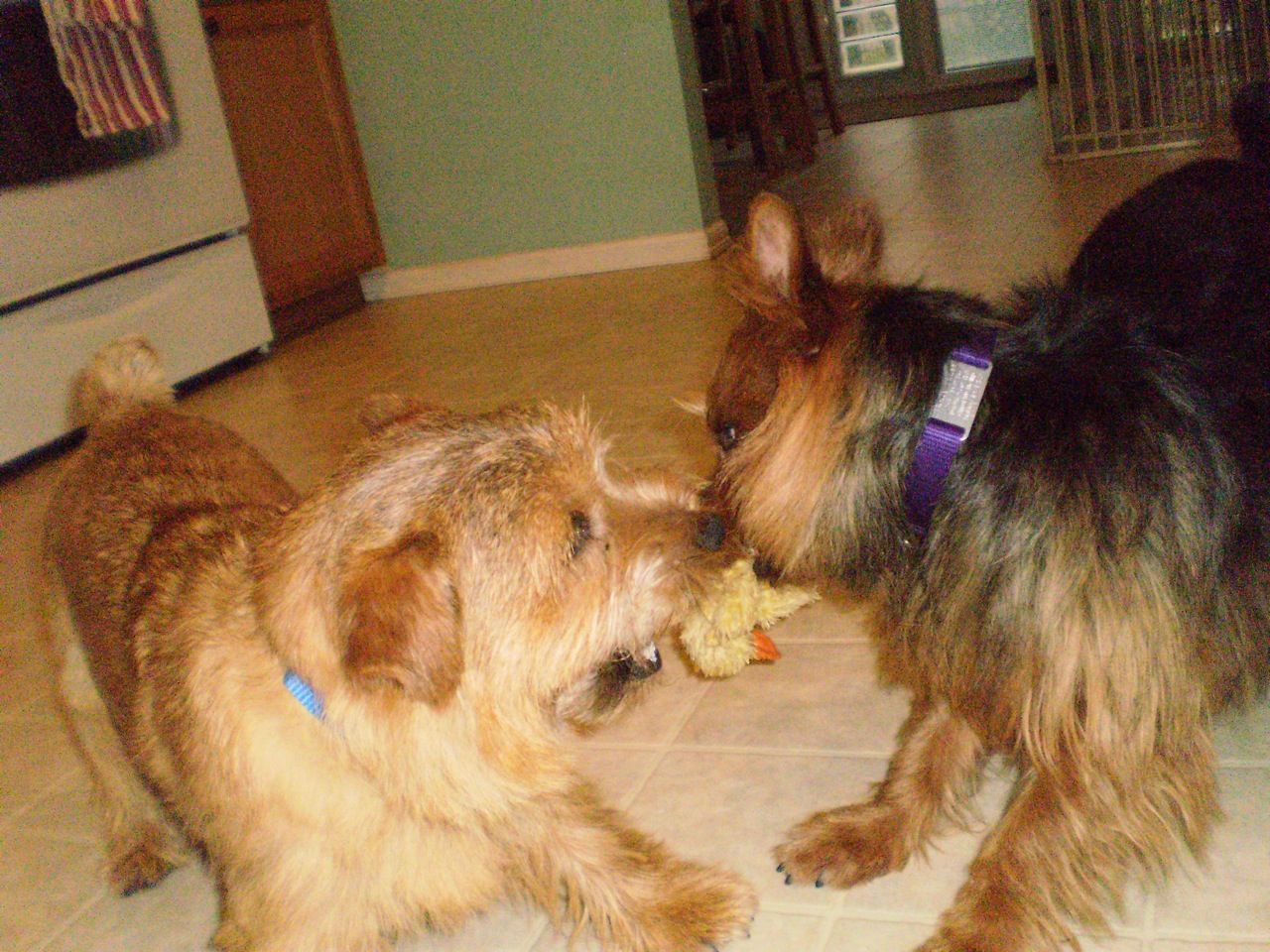
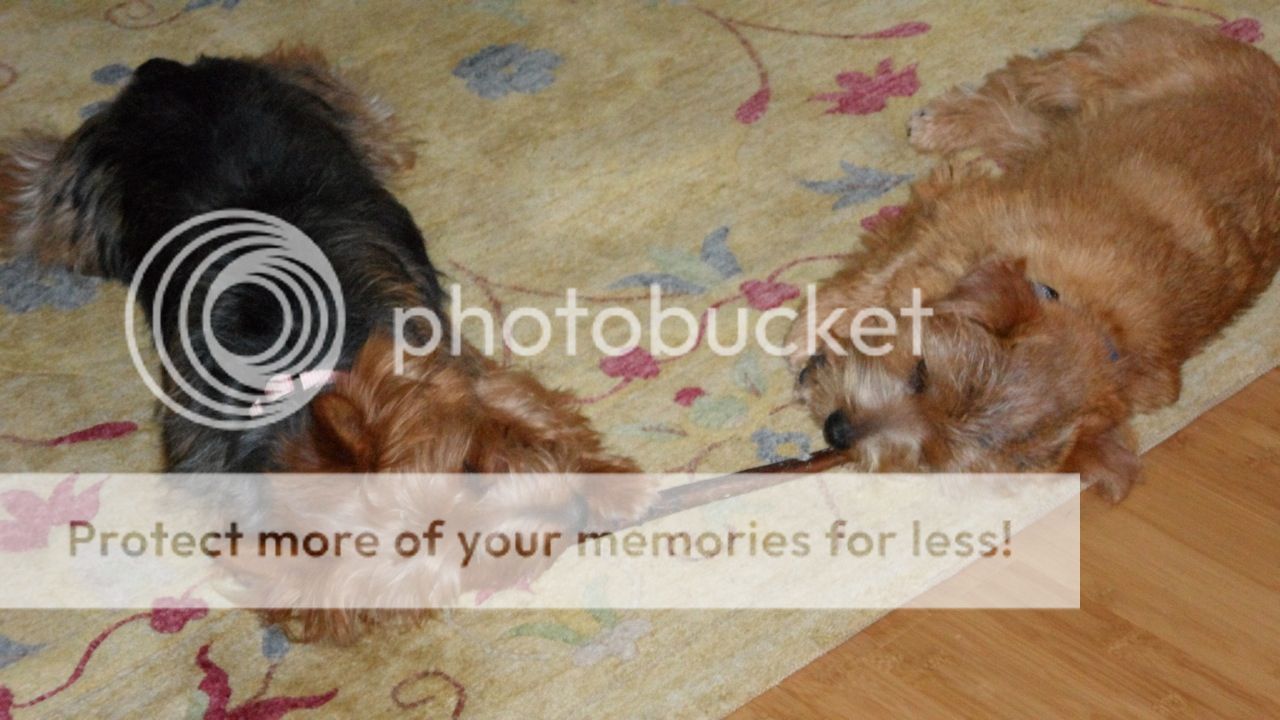
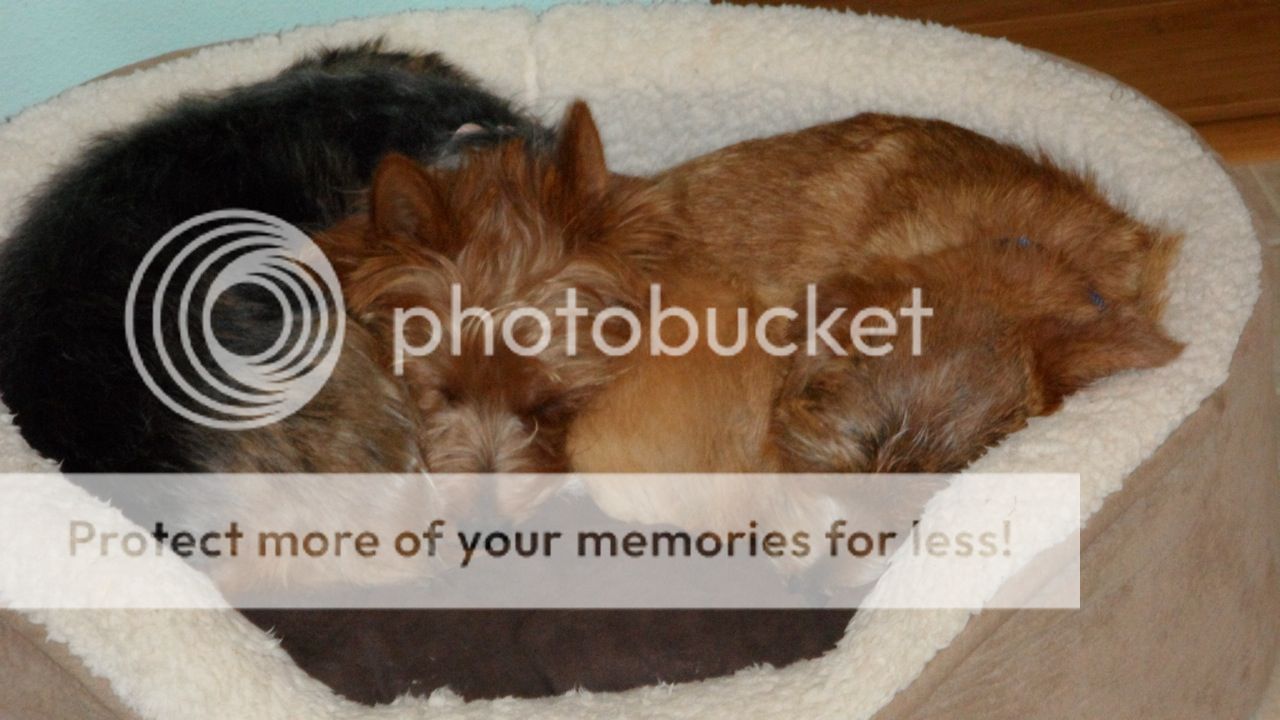
Mistakes happen in breeding but to perpetuate them is horrendous. It affects the breed and the people who purchase the dogs. Breeders should be honest with people who are interested in their puppies with issues. Then those who cannot afford the expenses can decline the puppy and those who can afford and want to take care of the puppy’s issues can do so with open eyes. It is very hard to bring a puppy back to exchange it for another puppy regardless of the health issues.
I wish I was the only one with a sad tale to share but I’m not. Please open your eyes and hearts. Do your best to improve the Australian Terrier breed. Be honest with the health of your puppies. Do health tests. Support and educate those who purchase your puppies. Getting a puppy is an emotional situation. Many, me included, see that puppy, fall in love and fail to truly read what they are signing. Do not take advantage of that. This is an amazing breed. Do your best to keep this wonderful breed, the Australian Terrier, something we can all be proud of.

The Passing Of Judy Stallings, Co-Founder Of ATI
Written By Pamela Levy

Judy Stallings
December 21, 1942 – March 8, 2012
On March 7th, I received an upsetting phone call that Judy’s two dogs Lida Rose and Diamond Dust “Dusty” had been placed in a kennel. Judy had lapsed into a coma as a result of her struggles with cancer. I was contacted, as a note had been left, that I was the responsible party. I caught the earliest flight once I secured care for my dogs, and was in Arizona at 11:44pm. Judy passed away at 11:35pm.
Her husband and my dear friend and mentor, Tom, had passed away on February 2, 2008. Just days after his passing Judy went in for testing and learned she also had cancer. She fought it bravely for 4 years. My heart is heavy as are so many hearts of all the friends they loved over their years both in Aussies and obedience.
Judy was instrumental in the formation of ATI. Her words of encouragement and her desire to be a co-founder were “the wind beneath our wings.” The loss of Judy and Tom leave a huge hole in my heart that can only be filled with my wonderful loving memories.

Phil Benway (Tom Stallings dear friend) went over to groom Lida Rose
for over 2 hours in her new home.
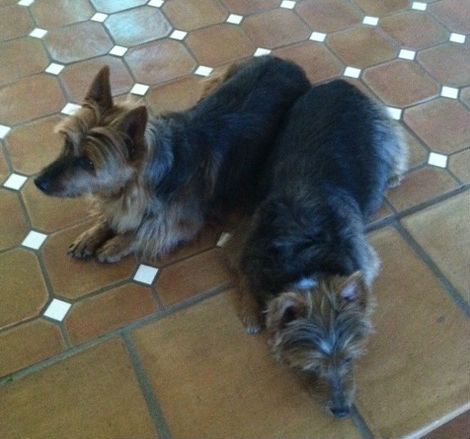
wonderful Whiteman family!
Lida Rose now lives with the wonderful Whiteman family who also own Tom and Judy’s dog Hooty. They could not have been more helpful to me personally during this difficult time. I can never thank them enough and know Judy and Tom smile down on them for their love and generosity.

Dusty and I make a stop on our way back to Aspen from Arizona.

Dusty was with me for a month and is now with Scott Pruter and is sharing her life with their two Aussies. I thank Scott and Carol Harriman so much for opening their hearts and home, as well.
Blue coloration is common across animal breeds. Horses, dogs and cats may all be born blue (gray). The blue (or gray) is caused by a dilute gene that masks the appearance of the base coat color. A palomino horse (blonde, with white mane and tail) is really a sorrel (red/brown) with a gene that masks the color. A gray can be black or chestnut with dilute genes masking the color.
In dogs, notable examples are the Weimaraner, brown dogs with the dilute gene, and various Doberman colors, blue, fawn and Isabella. The gene itself is a mutation that is responsible for transporting and fixing melanin-containing cells. This mutation is recessive, so two copies are necessary to cause the dilute coat color. Black, brown and yellow dogs may all be affected by the mutation. Black or brown dogs carrying the double dilute gene may appear blue, grey or buff; yellowdogs may appear cream or white.
The chart below shows the mode of inheritance of the dilute color.
The dog carries two copies of the dominant “D” allele. The dogwill express a normal, non-dilute coat color and will always pass
on a copy of the “D” allele to all offspring.
Both the dominant and recessive alleles detected. The dog will have a normal, non-dilute coat and is a carrier of the dilute coat color. The dog
can pass on either allele on to any offspring.
The dog has two copies of the recessive “d” allele and will have a dilute colored coat. He will always pass on a copy of the dilute allele to any offspring.
Accordingly, dogs with normal coat color can produce pups with normal or dilute color (if they carry the recessive “d” and are bred to a partner that also carries the “d”). Blue dogs can produce blue coat color if bred to partners that are blue also (dd) or that are normally colored but carry the recessive dilute (Dd). Two blue dogs bred together can only produce blue coloration (dd).
Unfortunately, there is also a connection between the blue color and Color Dilution Alopecia, a hereditary skin disease. CDA initially causes a dry, dull hair coat, withhair loss following. The disease is found in several breeds of dogs that have blue or fawn colored mutations. The highest incidence is in the blue Doberman Pinscher (93%) and fawn Irish Setter (73%). Other breeds in which color dilution alopecia has been observed include Miniature Schnauzer, Dachshund, Chow Chow, Poodle, Great Dane, Whippet, Yorkshire Terrier, Chihuahua, Italian Greyhound, Saluki and Newfoundland.

The dark grey puppy, “Koko.”
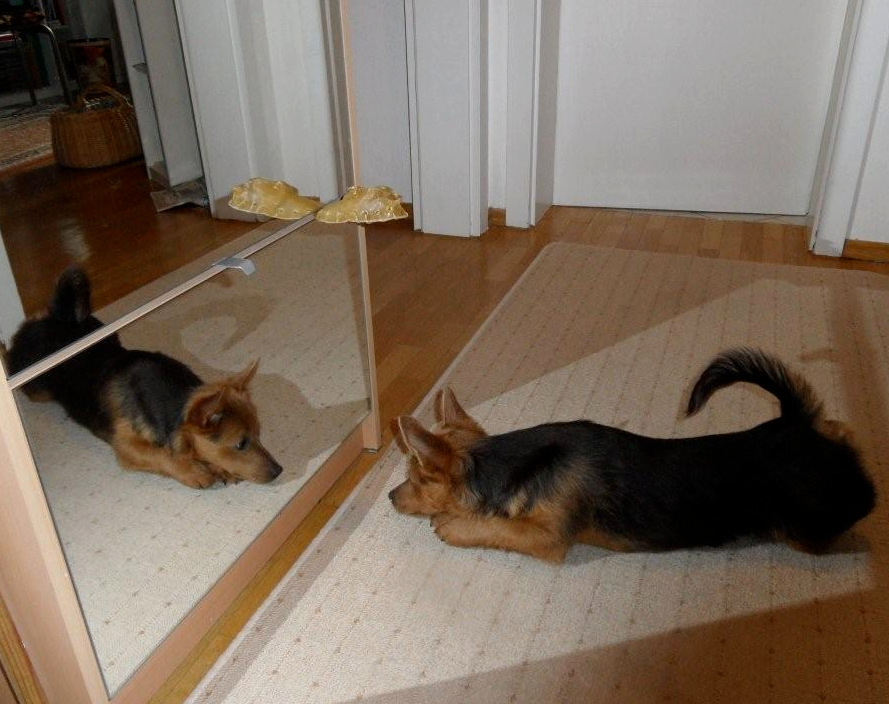
The bright grey puppy, “Kathinka.”
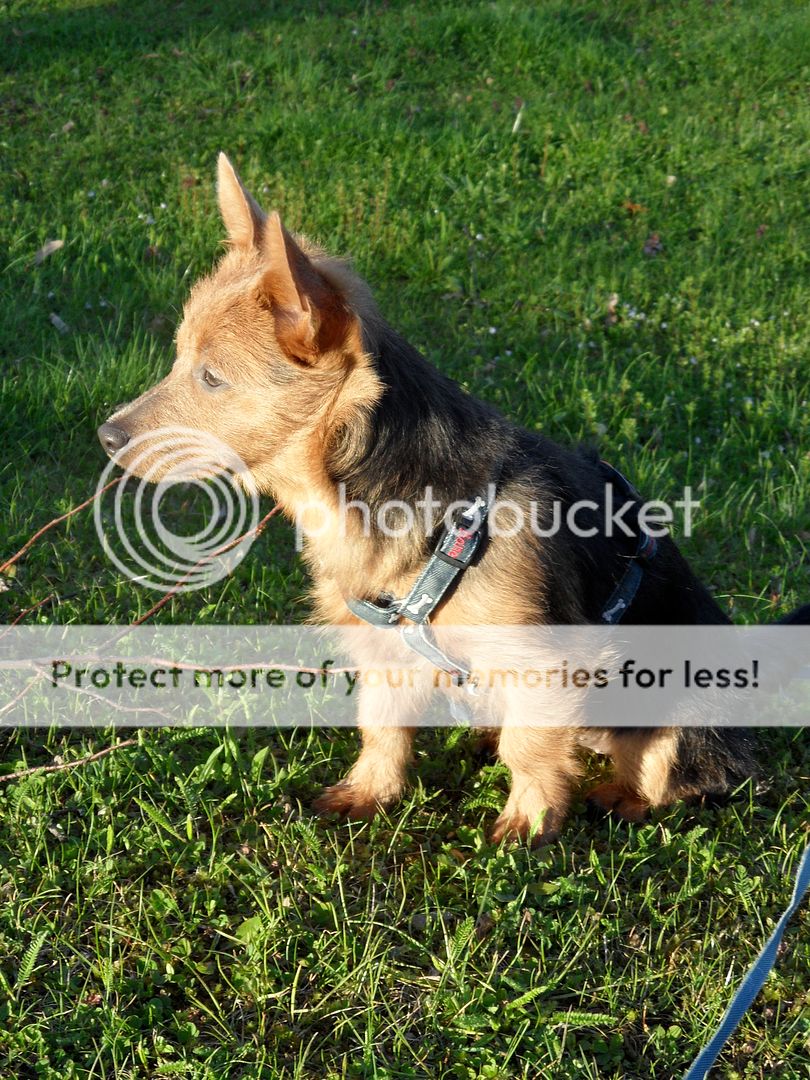
Reprinted with permission from Cher Hildebrand, Goldenray Yorkies.
This article was printed in The Yorkshire Terrier Magazine © 1999.
Genetics Chocolate Yorkies * Red * Golden * Blue Borns
The Yorkshire Terrier is genetically a Black/Tan (B/T) dog that turns blue later in life. The blue color is created at another loci by the GG or Gg genes. Whenever you have a dog born one color that turns blue later in life, it is the GG or Gg genes that cause this to happen.
Recently I received a call from someone asking about the Yorkie blue born puppies. That was a real blast from the past. I had not heard of anyone having blue born puppies in some years. When a dog is born blue it is different genes that effect the GG genes. The dd gene is what causes this at birth and the Yorkshire Terrier should only be carrying the DD. A blue born puppy will also have self colored pigment, such as blue nose. The DD gene is what allows them to be born Black/Tan. The upper case always means dominant and the lower case always means recessive. This is obviously a deep buried recessive that the animals are carrying that they have passed onto the resulting puppies. The breeds that are born blue are born with the dd gene, but in Yorkshire Terriers this should not be the situation to cause the blue coloring.
Unfortunately with blue born puppies the situation is usually fatal. Very few live beyond the 1st few days. The ones that do survive almost always at the time they would normally break blue, lose all their blue body coat and get a very leathery skin that is like an elephant hide and causes the dog to be in extreme pain. At that time the dog has to be humanely put down. I have heard of a couple that have lived a normal life, but I think there are very few that do. Do not be tempted to raise one of these as you are opening yourself to heartbreak, let alone what the dog will go through later in life.
The red or chocolates are affected by the bb genes. The red or chocolates or referred to as liver in some breeds will also have self colored pigment, such as red, chocolate or liver nose. They should only be carrying the dominant BB genes. I have not heard of health problems with the red/chocolate born puppies, like with the blue born puppies. Yet most of these situations occur with backyard breeders and puppy mills and they are not likely to share the history of problems with the show breeders. Once again this is a recessive being passed on to the puppies from the parents. This breeding should definitely not be repeated.
Blue born puppies and red/chocolate born puppies are not acceptable colors in the breed. They should only be born Black/Tan and later turn to a dark steel blue. The blue born puppies and red/chocolate born puppies are recessive colors being passed to the progeny and a repeat breeding should never occur. Puppies of these colors should not be sold as rare colors. Yes hopefully it is very rare to get them, but these are totally unacceptable colors and it’s not so much that they are rare, as that they are not true representatives of the breed. Do not be misled by unscrupulous breeders about these dogs. Makes one wonder if there is more in the background of these dogs. There is a backyard breeder in my area that has produced red born puppies and solid black born puppies in one litter. I have to assume that she does not really have a purebred to have this happen. Another backyard breeder south of me sells her solid black ones as rare teddy bears. One new owner was sent to me by her vet because he told her the dog was definitely part black Poodle. When I saw the dog, there was no question that it was at least half Poodle. Actually it looked nothing like a Yorkshire Terrier but entirely like a Poodle. She had all intentions of breeding this dog herself and had enough sense not to give me the AKC registration number for me to report it.
As concerned breeders we would only want to breed dogs that are producing the only acceptable color of the breed which is a Black/Tan puppy that as an adult dog will be blue and gold. As an owner or potential owner of one you should only want the blue and gold, because that is the Yorkshire Terrier. Any other color really makes it something other than this breed. As a breeder, you should not knowingly breed a dog that is producing such a known defect. The breed could shortly become other than what it is. For instance, the tri colors that are produced in some of Europe. This is not what a Yorkie should be. If you want a tri color dog then get a breed that should produce tri colors.
The standard laid down by the YTCA is very specific about them. It states the puppy should be born Black/Tan and change color to a Blue/Tan dog later in life. Nowhere is it written that the dog should be born any other color than Black/Tan. Standards are written to protect our breeds. The blue born is a perfect example of why. The health problems associated with this color make it critical that we stick to the color the breed is suppose to be, which means being born Black/Tan and later changing to a Blue/Tan dog.
Yorkie Color Dilution Alopecia – CDA Alopecia is the term for hair loss and is part of the problem with dilute coat colors, most especially the blue coloring and is a known inherited disease in dogs. This condition could affect any dilute color of dog if they are carrying the genes. The disease is also known as Blue Born Puppies in this breed, and in other breeds has been known as Blue Balding Syndrome or Blue Doberman Syndrome so even more information can be found under those names. These dogs as a rule have red noses or blue noses also. CDA has been seen in a great many other breeds of dogs. Dilute dogs carry recessive genes of dd and are seen with blue or flesh colored noses, lips and eye rims. The coat colors may include blue or fawn variation of these different colors.
To read the article at Goldenray Yorkies website CLICK HERE
Australian Terrier International Named One of
Aspen, CO- March 20, 2012
Australian Terrier International (ATI) a provider of dog care information, has received the 2011 All Star Award from Constant Contact®, Inc., the trusted marketing advisor to more than half a million small organizations worldwide. Each year a select group of Constant Contact customers are honored with the All Star Award for their exemplary marketing results. ATI’s results ranked among the top 10% of Constant Contact’s customer base.
The Mission of ATI:
“There is nothing we like more than to see our customers finding success. It’s the reason Constant Contact was founded, and it’s a thrill to see the fantastic results that our All Stars are achieving,” said Gail Goodman, CEO of Constant Contact. “This group is really leading the charge when it comes to delivering relevant, engaging content that drives real business results. We salute this year’s All Stars for their success, and are honored to have played a part in their achievements.”

*Opening this in Safari alters the color of this image and makes it black.
I was contacted over a year ago by Tammy as she was interested in learning how to groom an Aussie for a competition. We made a few attempts to get together but never followed through. This year she wanted to enter an Aussie in the June competition. She wanted to visit me and have me teach her how to groom an Aussie.
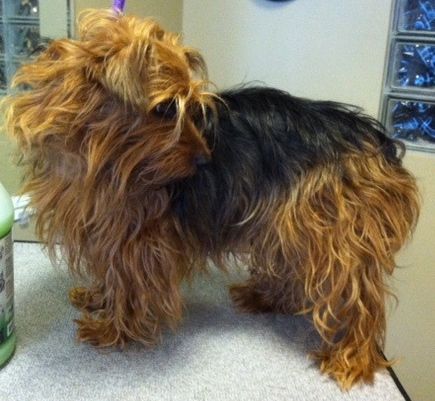
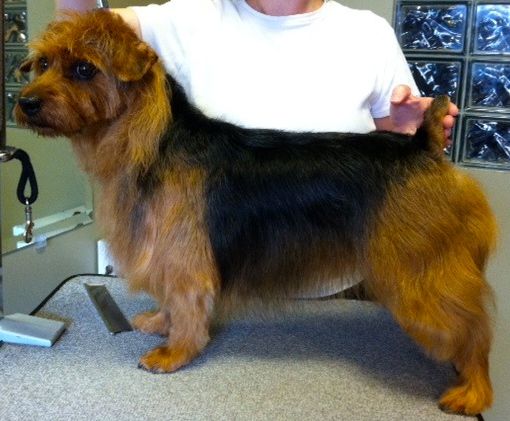
Debbie Miller has been involved with Australian Terriers for many, many years. After losing her Miss Marta to a heart condition, she started to look for a rescue dog. What she found on Petfinders.com really upset her. She found many dogs listed as Aussies and mixed breeds that looked alarmingly like Aussies and wondered why they weren’t in loving homes. She contacted ATI.
ATI is frequently contacted by people looking for Aussie rescues and although we always tell them to first check with Australian Terrier Rescue, there are not always rescues available. Debbie has put together a list that is now on ATI’s web site. She updates this site weekly. The rescues are listed by state.
We do not know anything about these dogs other than what their page says on Petfinders. They may indeed just look like Aussies and not be Aussies. We have no idea about temperament or health.
However, one dog labeled as a Cairn and looking very much like an Aussie, has a story that says its owner died of cancer and the dog was put in a high kill shelter.
To view these rescues click here
Pat Hastings And The Rule Of Sevens
By the time a puppy is 7 weeks old it should have:
Been on 7 different surfaces, such as: carpet, concrete, wood, vinyl, grass, dirt, gravel, wood chips, newspaper, etc.
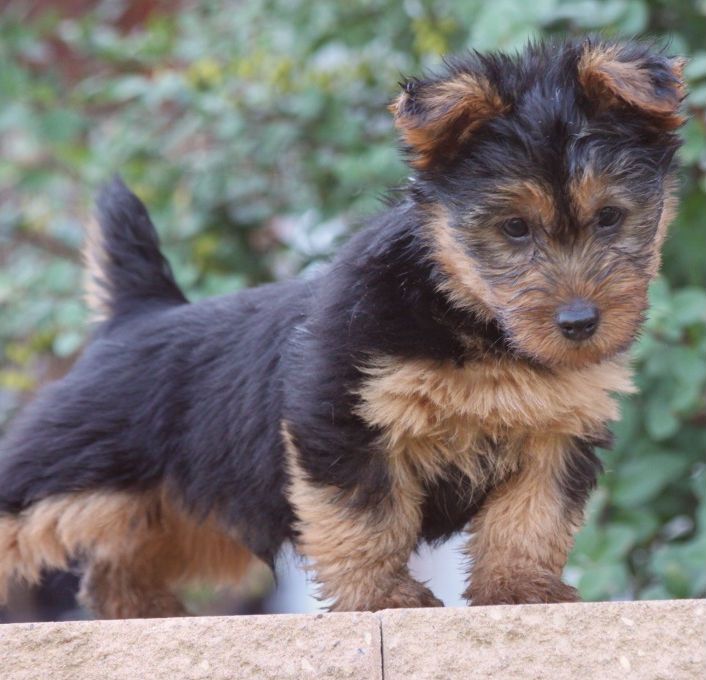
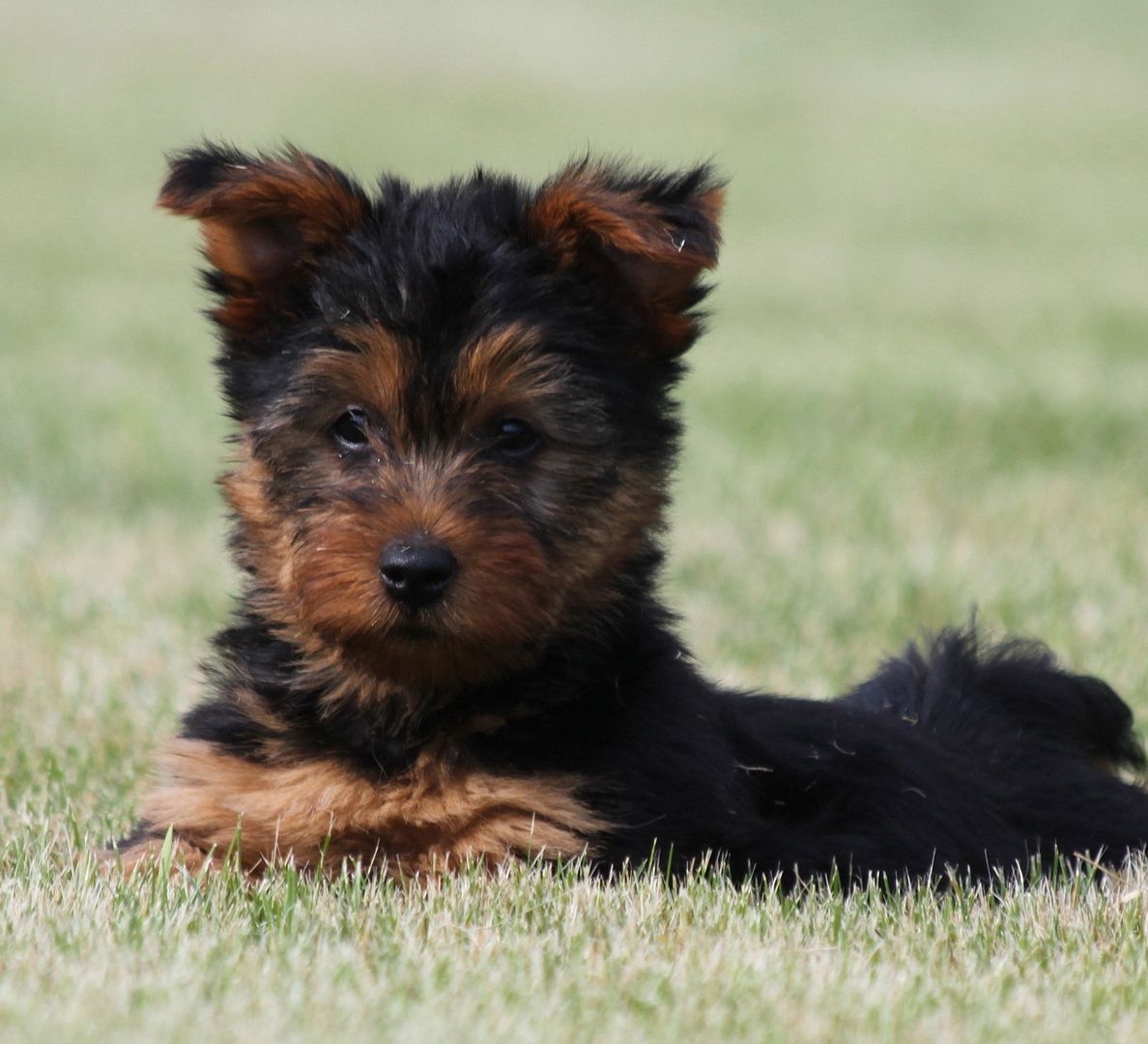
“Miles” Bustamante
Played with 7 different types of objects, such as: big balls, small balls, soft fabric toys, fuzzy balls, squeaky toys, metal items, wooden items, paper/cardboard items, milk/soda jugs, etc.
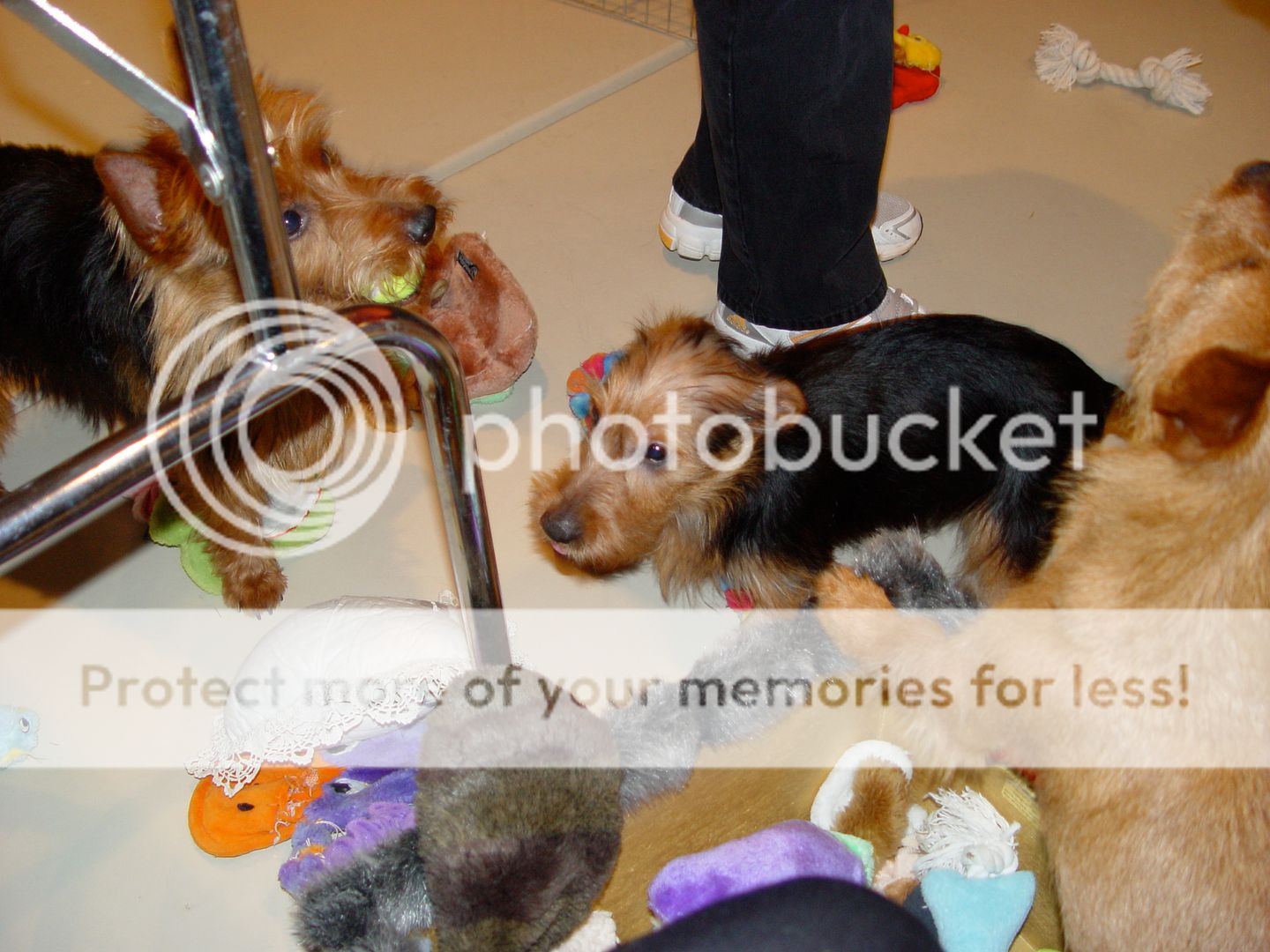
Been in 7 different locations, including: front yard, backyard, basement, kitchen, car, garage, laundry room, bathroom, crate, kennel, etc.

Been exposed to 7 challenges, such as: climbed a box, climbed off a box, gone through a tunnel, climbed up steps, climbed down steps, climbed over obstacles, played hide and seek, gone in and out of a doorway with a step, etc.
Eaten from 7 different containers: metal, plastic, cardboard, paper, china, pie plate, frying pan, etc.
Eaten in 7 different locations: crate, yard, kitchen, basement, laundry room, bedroom, x-pen, etc.
Met and played with 7 new people, including children and the elderly.
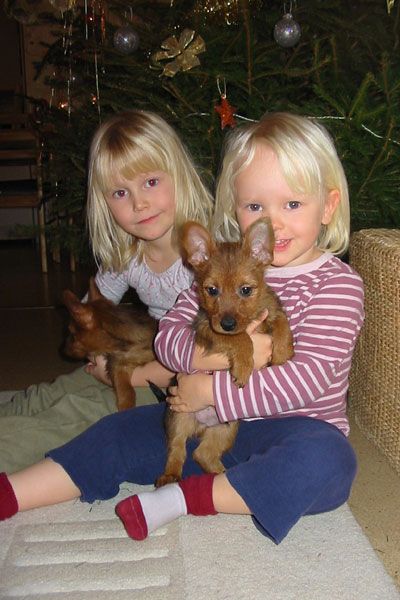
Photo Courtesy Of Terhi Oksanen
Now, common sense dictates that you shouldn’t make your five-week old puppy eat alone in the back yard if it’s January and you live in Maine. And I don’t know about you, but I’m not sure I’ll let my next litter learn about “real food” from dining on my best china. However, Hastings’ point is that early socialization is important. Many larger breeds leave for their new homes at about eight weeks of age, while those of us with Norfolks tend to place our puppies several weeks later. In any case, early socialization, which includes stimulation from a variety of sources, can go a long way toward producing an outgoing, confident adult.
|
We Love Books
|
|
“I Am an Australian Terrier” by Theresa A. Goiffon.
To Purchase Click Here
.
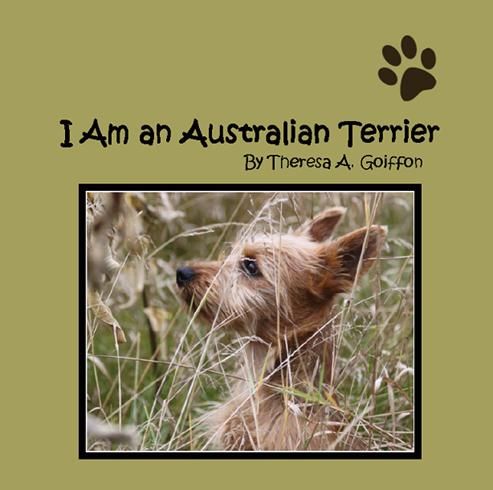 Book Review by Dianne Wall
If I were asked to make a list of my favorite things, it would be difficult keeping track of all that I love. However, there are two things that I know would be high on that list: books and Australian Terriers. So when I learned that one of our ATI founders, Theresa Goiffon, published a children’s book about Australian Terriers, I was eager to be one of the first in line for a copy. Theresa is no stranger to our ATI family so it is no surprise that she found inspiration for her book literally right under her feet. She gives us a look into the life and character of our beloved Australian Terriers by showcasing her own pack of Aussies. According to Theresa, I Am an Australian Terrier is the first in a series of picture books targeted toward children. Using simple, poetic prose Theresa gives the reader not only an accurate description of Australian Terriers but a look into the world in which they live. While her charming book is targeted toward a young audience, it is a joy for anyone of any age to read. Those of us who share our lives with Australian Terriers will get extra enjoyment recognizing the antics of our own dogs in the pages of this book. This little book is beautifully illustrated with Theresa’s own photographs of her dogs and puppies proving that she is equally as talented as a photographer as she is an author. Perhaps the best review of all came from my three year old niece, Sophia. She loves the pictures so much that she doesn’t want to be read to; she just wants to see the pictures over and over again! I think we Aussie lovers can understand that, too. I Am an Australian Terrier is now available through the ATI website by clicking above. Theresa will donate a portion from the sale of each book to ATI, which in turn uses its funds to support the CHF. |
|
We Love These Toys
|
Pocketdiscs
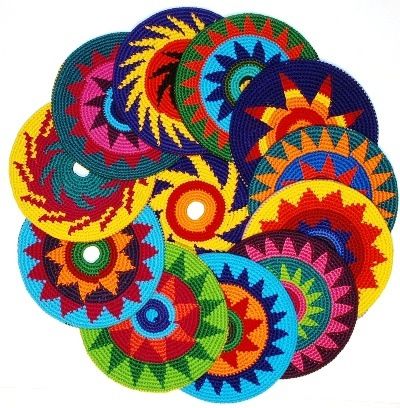 Fun to throw for your Aussie but avoid a game of tug-of-war with it. It is house and tooth friendly and packs easily for a walk or a vacation. |
|
We Love These Apps
|
| MapMyDOGWALKThis free app for iPhone users allows you to keep track of just where and how far you and your Aussie have gone. It uses your iPhone’s GPS function to track your route in real time while also displaying your distance, pace, speed and elevation. |
|
Love Is Education
|
| Get Dog Food Recall Alerts by EmailGet dog food recall alerts delivered right to your Inbox the moment we become aware of them. Subscribe to The Dog Food Advisor’s Dog Food Recall Alert email notification list now. Click here
|
|
Alternate Dog Treats – Healthy Options Made Easy
|
|
Whether your veterinarian has advised you to put your dog on diet, or you happen to have a dog with specific food allergies, finding healthier treat options doesn’t have to be difficult. In fact, it can be as easy as simply opening the produce drawer in your refrigerator. Need some suggestions? Try these veterinarian-recommended goodies that are tasty and safe for your pet.
Getting Started
Fresh fruit and raw vegetables are a healthy treat option for dogs; there aren’t any added chemicals, artificial flavors or coloring and your pet benefits from the extra vitamins and minerals.
However, just like kids, dogs can be picky eaters. You may discover that while one particular fruit or vegetable suits your pet’s palate, another may have him disdainfully turning his nose away.
Don’t bombard your dog with an assortment of fresh goodies when first introducing a new food group; start by treating your dog to one particular fruit or vegetable at a time for a few days. By doing so, you can pinpoint whether or not the treat du jour is causing an upset stomach or diarrhea.
It’s important not to feed your dog toxic fruit or vegetables, warns Dr. Tony Buffington, a diplomate of the American College of Veterinary Nutrition. Buffington has a PhD in animal nutrition, was a resident clinical nutritionist at the Veterinary Medicine Teaching Hospital at UC Davis, and has been a professor of veterinary clinical sciences at Ohio State University’s College of Veterinary Medicine since 1987.
“With regard to alternative treats, we recommend small amounts of fruits and veggies all the time,” advises Buffington.
Before stocking your fridge, take note of which fruits and vegetables are safe to feed your dog.
Safe Fruits to Feed Dogs
With the exception of citric fruits, which may upset your dog’s stomach, most fruits are safe to feed to your pet. Importantly, never feed your pet a whole fruit with a pit or seeds intact. The pit is a choking hazard, and seeds can lead to gastric issues and be a choking hazard as well. Clean the fruit, then slice it in pieces and give to your pet as a treat.
Fruits to Avoid Feeding Your Dog
Fruits to avoid feeding your dog include grapes and raisins, peaches, plums and persimmons.
The specific problem with persimmons, peaches, and plums are the seeds or pits. The seeds from persimmons can cause inflammation of the small intestine in dogs. They can also cause intestinal obstruction, a good possibility if a dog eats the pit from a peach or plum. Plus, peach and plum pits contain cyanide, which is poisonous to both humans and dogs should the pit be broken open and consumed.
According to Pet Poison Helpline, grapes and raisins have been known to cause acute renal (kidney) failure in dogs. With kidney failure, a pet’s ability to produce urine decreases, which means they are unable to filter toxins out of their system. Unfortunately, the reason for kidney failure and the amount of grapes/raisins necessary to be toxic to pets is unknown, so all cases of ingestion have the potential to be grave. Depending on the size of the dog, as little as four grapes/raisins can have an adverse effect on your fuzzy friend.
Safe Vegetables to Feed Your Dog
Your dog may have his own preferences when it comes to vegetables, so don’t be deterred if he abandons your first veggie snack on the floor. Try some of these more savory vegetables:
Keep in mind that cabbage, cauliflower and broccoli may cause gas in your dog. Try feeding your dog sliced pieces of the cauliflower and broccoli stems rather than a floret; not only will the stem satisfy your dog’s crunchy craving, but he may appreciate not having to deal with the tiny floral buds that become lodged in his teeth or tickle his throat.
Vegetables to Avoid Feeding Your Dog
There are a few vegetables to avoid feeding your dog at all times. Onions, garlic, wild mushrooms and rhubarb can be extremely toxic to your pet.
Onions contain an ingredient called thiosulphate which is toxic to cats and dogs. The ingestion of onions, onion powder, or even cooked onion causes a condition called hemolytic anemia, which is characterized by damage to the red blood cells. In other words, onion toxicity can cause the red blood cells circulating through your pet’s body to burst. A small amount can be toxic to your dog or cat.
Wild mushrooms – which may be found growing in your backyard or on the nature trail where you walk your dog – contain toxins that will trigger numerous organ systems, including the kidneys, liver and brain. Nervous system abnormalities, seizures, coma, vomiting, and death can all result when a dog consumes mushrooms.
Rhubarb contains oxalates which trigger abnormalities with the nervous system, kidneys and digestive tract. The vegetable is also commonly used in recipes for pies, jams, jellies, sauces and juice.
Smart Choices for a Healthy Pet
It’s important that you be aware of your dog’s unique dietary needs in order to ensure his lifelong health. Make smart choices about feeding treats to your pets, recommends Buffington.
“From a nutritional point of view, we don’t recommend feeding so much that the treats make any significant contribution to the pet’s nutrient intake, or dilute or imbalance their regular diet. We also remind owners that there are plenty of non-food treats from their pet’s point of view; play treats, walk treats, ‘teach me a trick’ treats, grooming treats,” says Buffington. “All of these contribute to a positive human-animal relationship without adding calories.”
If you are unsure of which alternate treat to feed your pet, discuss your concerns with your family veterinarian before introducing a new type of food to your dog.
Reprinted from VIP Pet Insurance to read the article Click here |
|
Dog Vacay
|
| Recently we learned of a new company for vacationing dog owners who need to board their dogs and for dog lovers who would be happy to dog sit for others and make a little money.
Their website states, “Dog Vacay allows you to find a real home to board your dog. It’s better than a kennel where your dog may be in a cage all day. Home boarding gives your dog individual attention, fun with a small number of well-socialized dogs, and supervision from a responsible pet owner at a price that doesn’t add up to more than your vacation.”
I think this is an interesting concept and could be very useful if you can find the right pet sitter for your Aussie(s). The rates start at $15/night.
If using this site for dog care make sure you read the About Me section and check their credentials. Also make sure you request and call their references. Many of these people have dogs so you will want to make sure your dog gets along with other dogs. Not all the dog sitters have fenced backyards so you may want to confirm that, as well. You may also want to make sure they are capable of giving medications if necessary and if they have taken any CPR classes for dogs etc. No one at ATI has tried them yet and we are letting you know what is “new” but can not make a recommendation at this time.
|
|
Food Recalls
|
| FDA inspectors probe pet jerky treats in China.
By JoNel Aleccia
Federal health officials have sent inspectors into Chinese plants that make chicken jerky pet treats, to investigate potential links to illnesses and deaths in hundreds of dogs in the United States, two lawmakers say. Staffers for Sen. Sherrod Brown, D-Ohio, and Rep. Dennis Kucinich, D-Ohio, confirmed Wednesday that Food and Drug Administration officials were conducting the inspections.
“Based on our ongoing discussions with the FDA, we are expecting important new information soon,” Vic Edgerton, a spokesman for Kucinich said in an email to msnbc.com.
It’s not clear exactly how many inspectors are involved or which plants the officials will visit as they attempt to solve the mystery behind at least 600 reports of illnesses including abrupt kidney failure after dogs have been fed chicken jerky treats made in China.
FDA officials declined to comment on the inspections.
|
| CHIC Testing In The USA
|
|
To learn more about CHIC testing please click on the link below. Australian Terriers are a CHIC tested breed. Australian Terrier Tests
CHIC Goals
CHIC Benefits
Once in place and accepted within the dog breeding community, the CHIC program offers benefits to breeders, buyers, parent clubs, and researchers.
Canine Health Information Center | 2300 E. Nifong, Columbia, MO 65201-3806 T 573-442-0418 FAX 573-875-5073 | contact © 2009 Orthopedic Foundation for Animals and Canine Health Information Center. |
|
Bark Out
|
| Once more the ATI Newsletter was very nice and well done. As usual I learned a lot. The article about Blue Dogs was very special. Had you ever heard about that before?
Congratulations once more for all the articles and the very nice photos. You are doing a great job. Marie-Francis Petry, Belgium Thank You, Marie-Francis. You always brighten our day with your warm comments. No one at ATI had ever heard about the “blue gene” before. We asked several “old time” breeders in many countries and no one we contacted, nor that the breeder contacted, had ever heard of it before.
|
Renew Or Join ATI |
|
|
|
Sincerely,
|

Pamela C. Levy
Australian Terrier International Privacy is important to us; therefore, we will not sell, rent, share or give your name or address to anyone. At any point, you can select the link at the bottom of every email to unsubscribe. Please note if you do not want to receive our emails, we do not want to bother you with them. Again, feel free to email us to be removed from the email list or unsubscribe using the link below. Thank you so much.
|